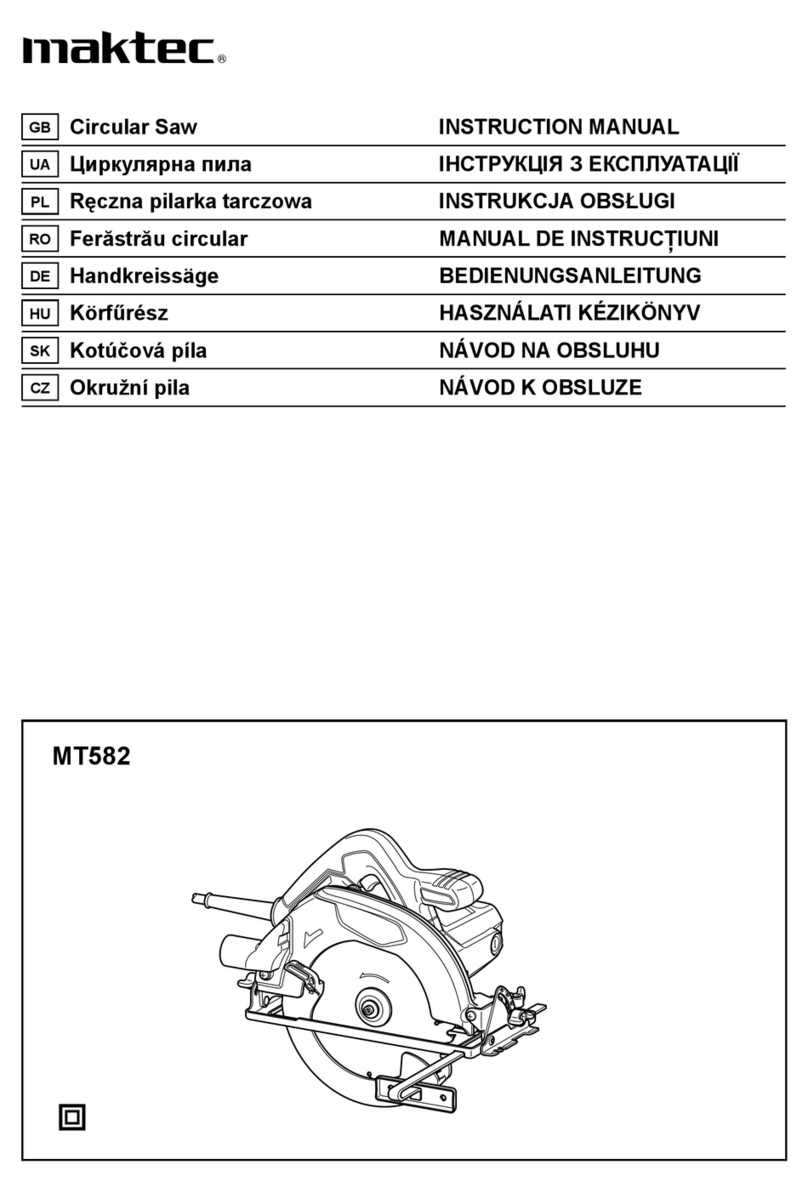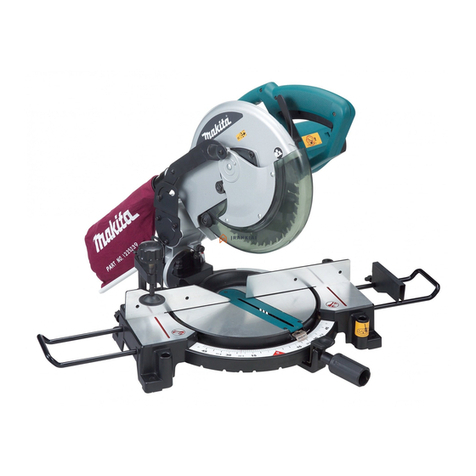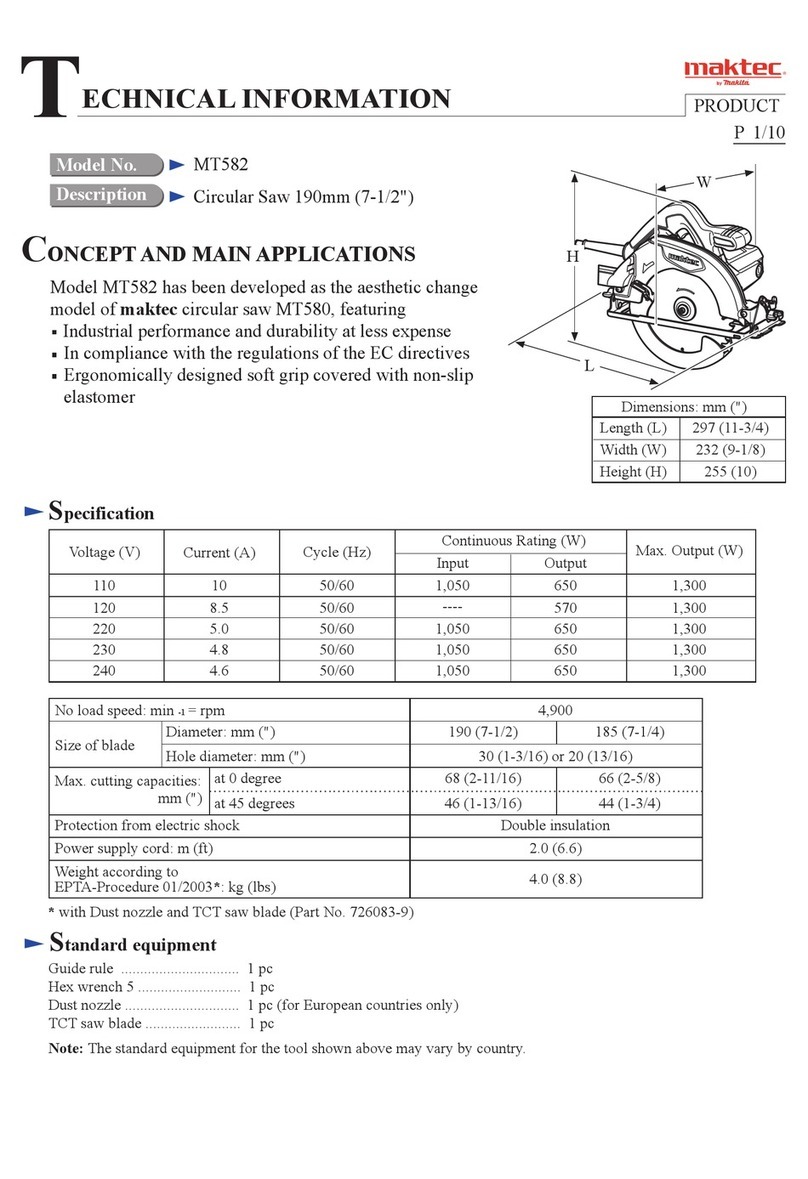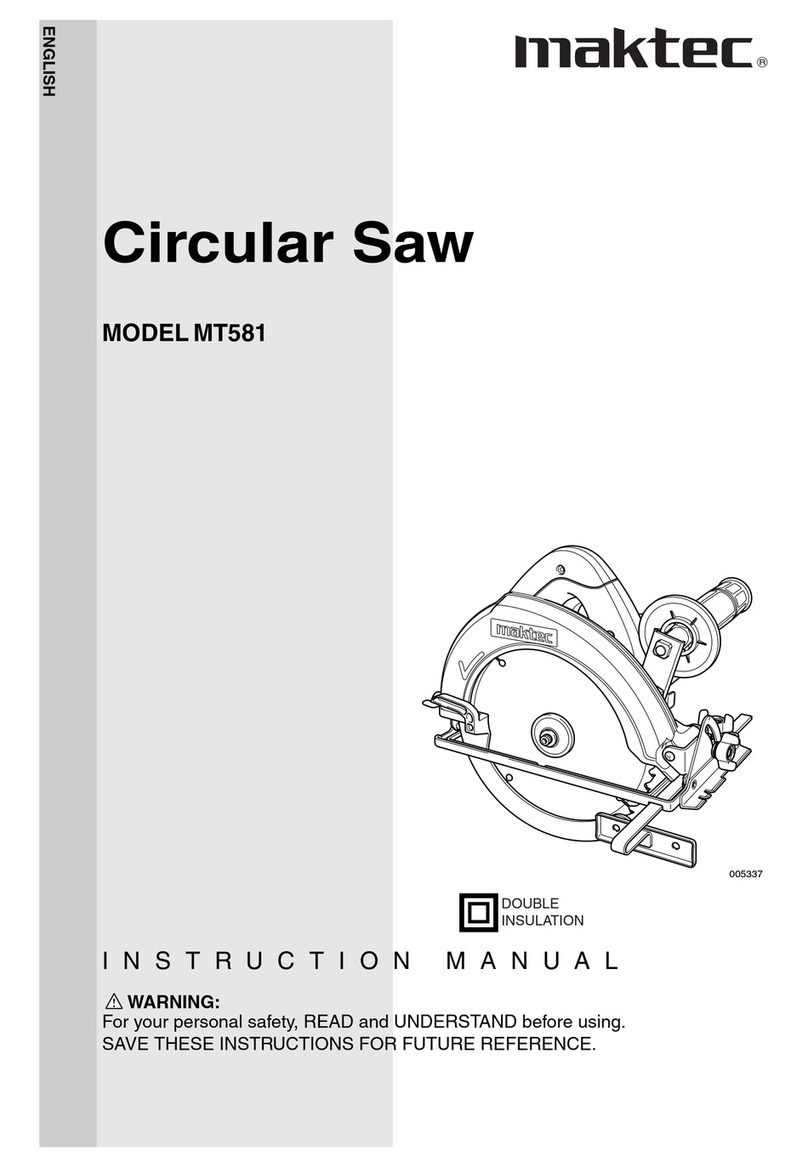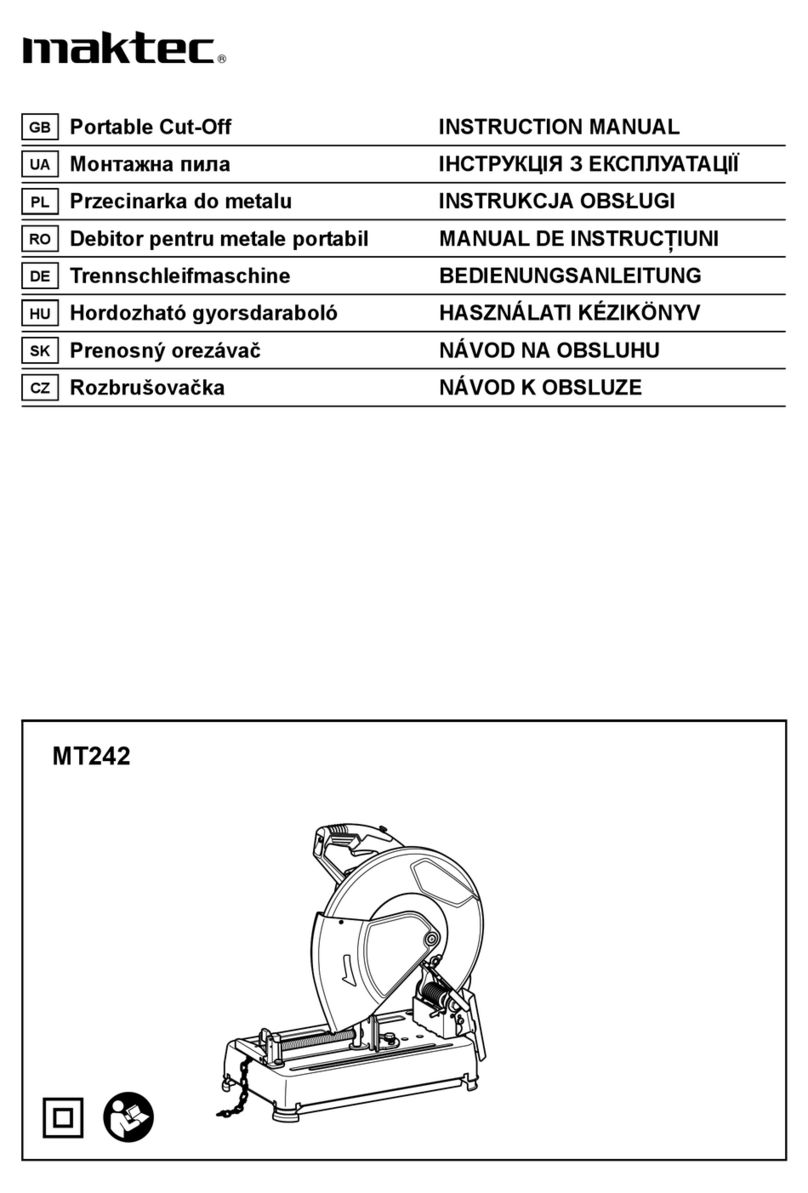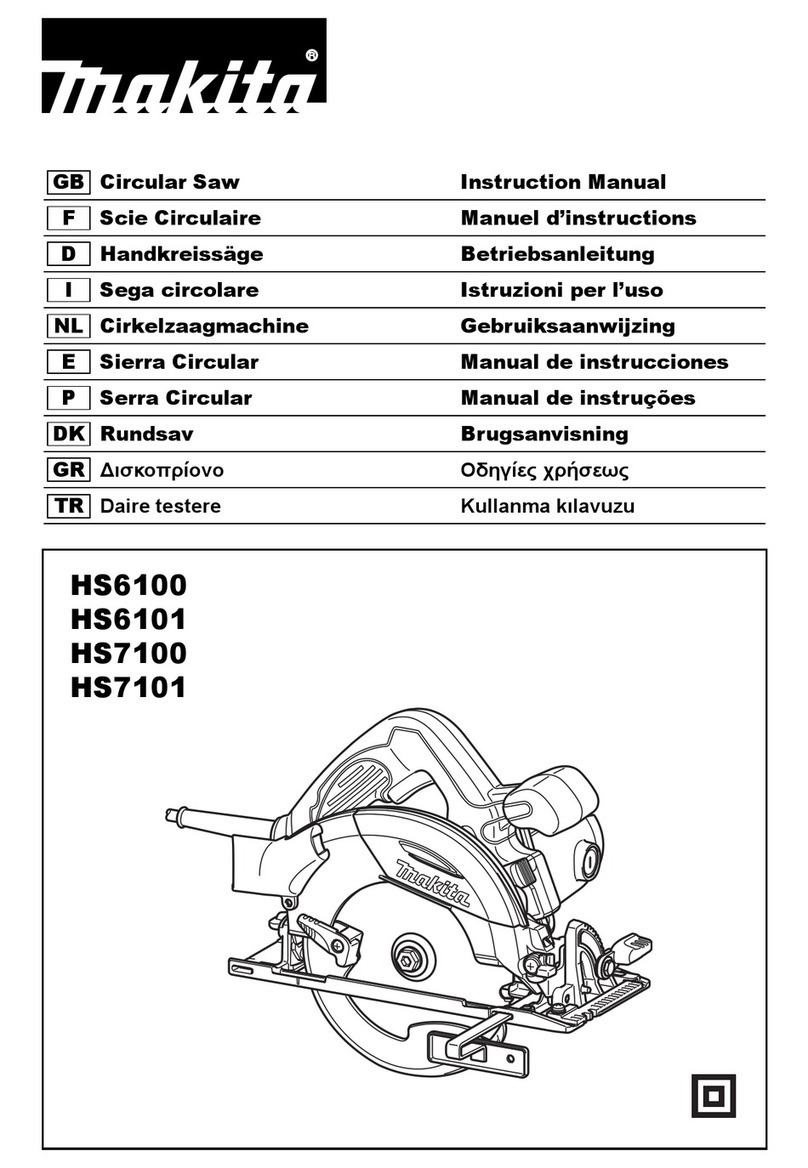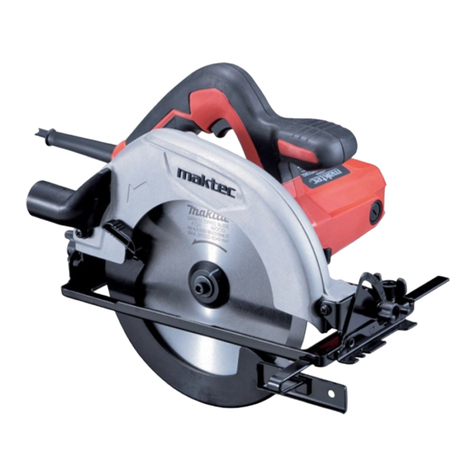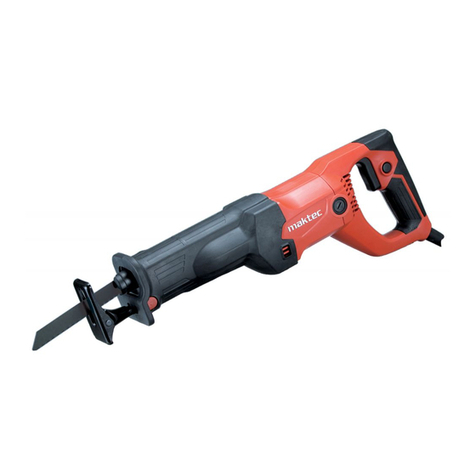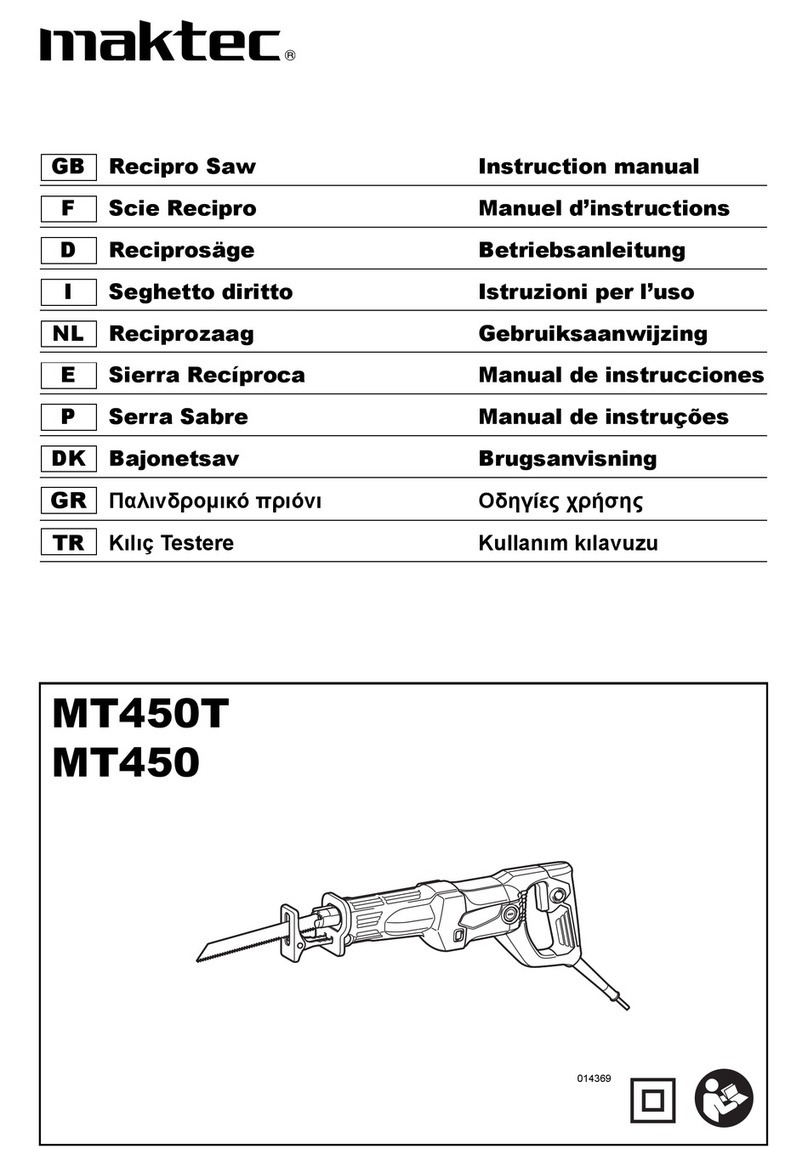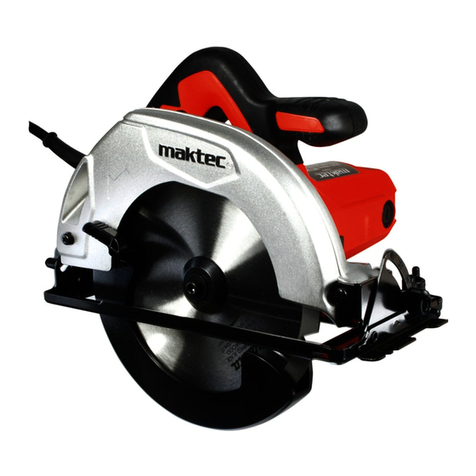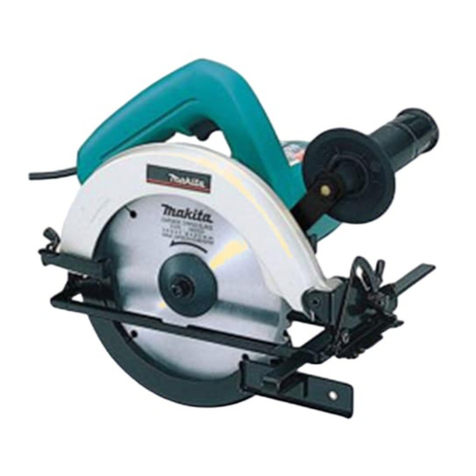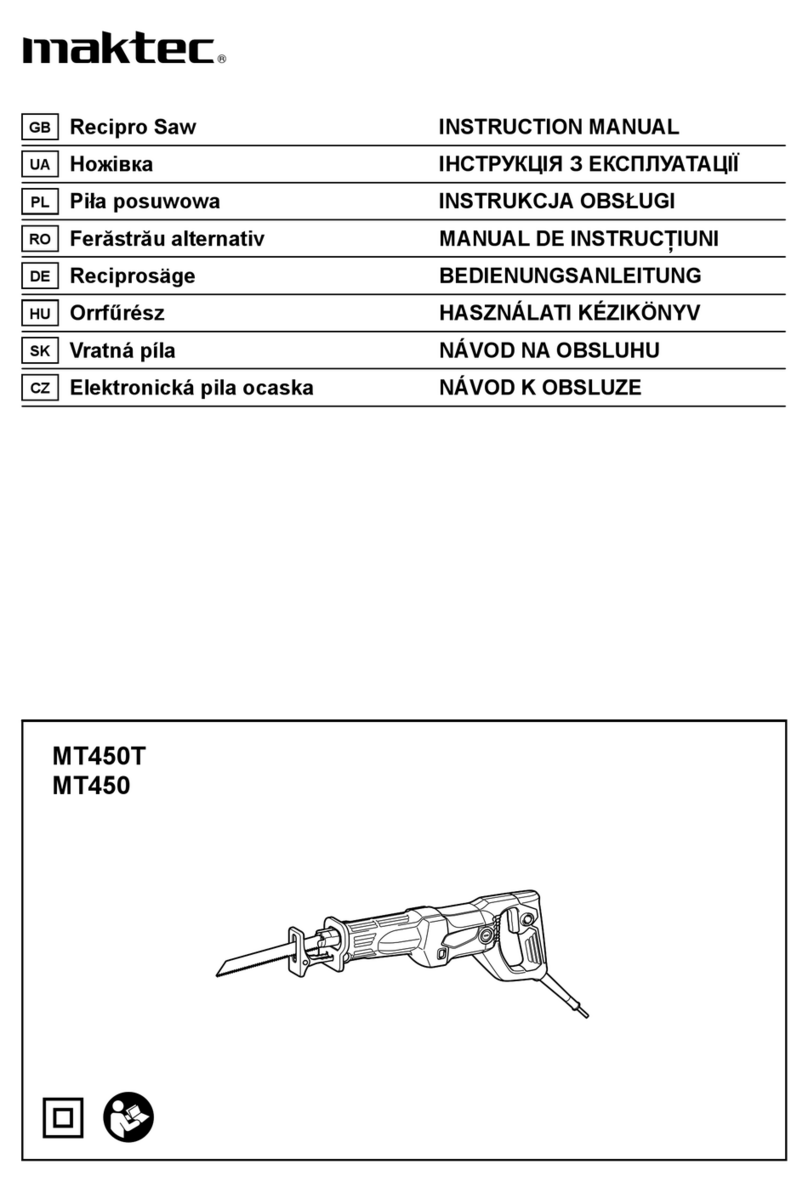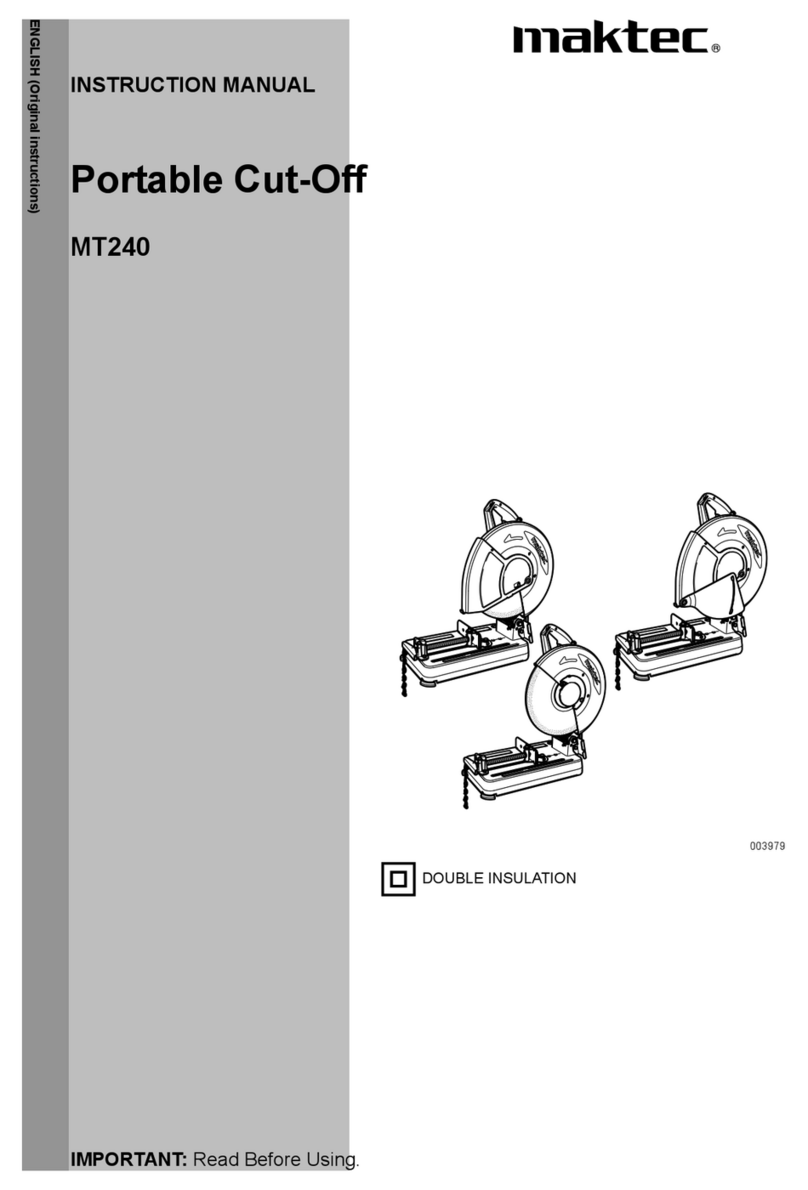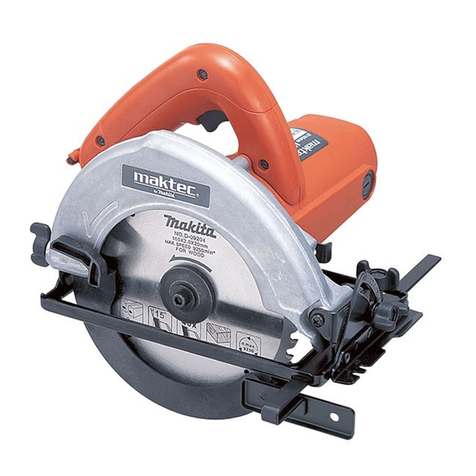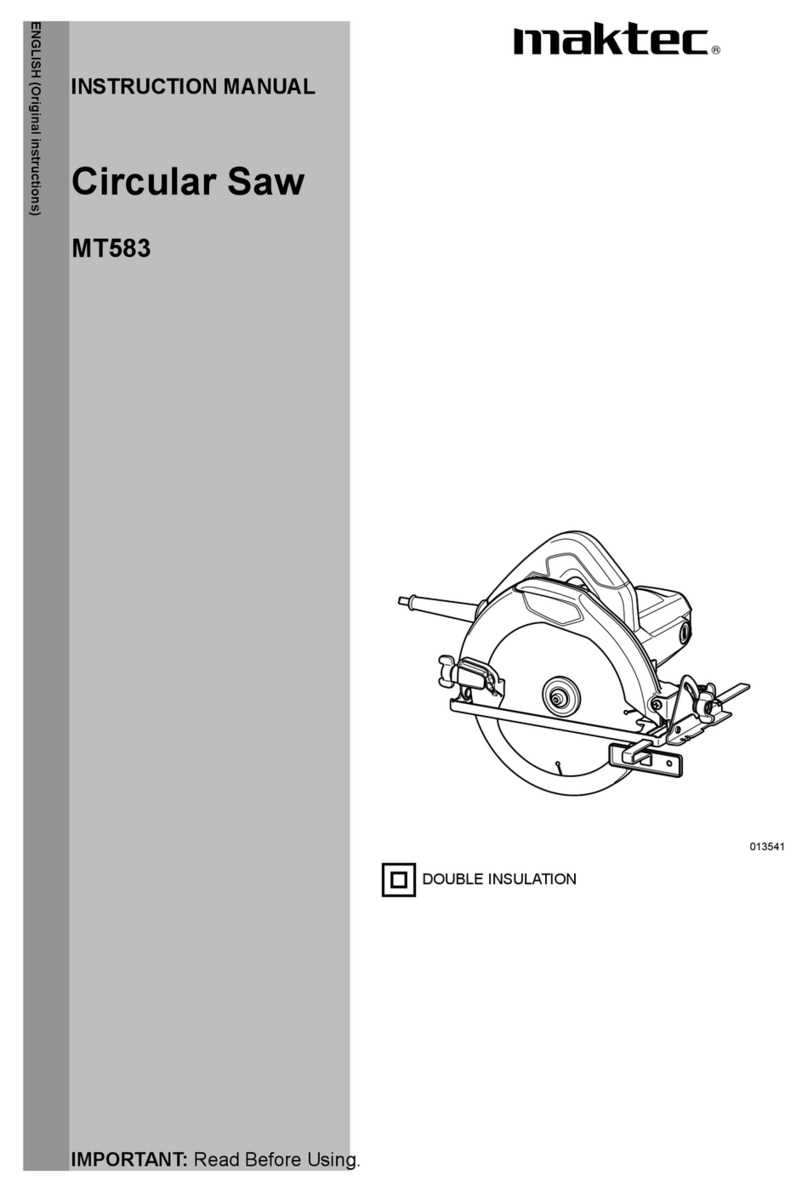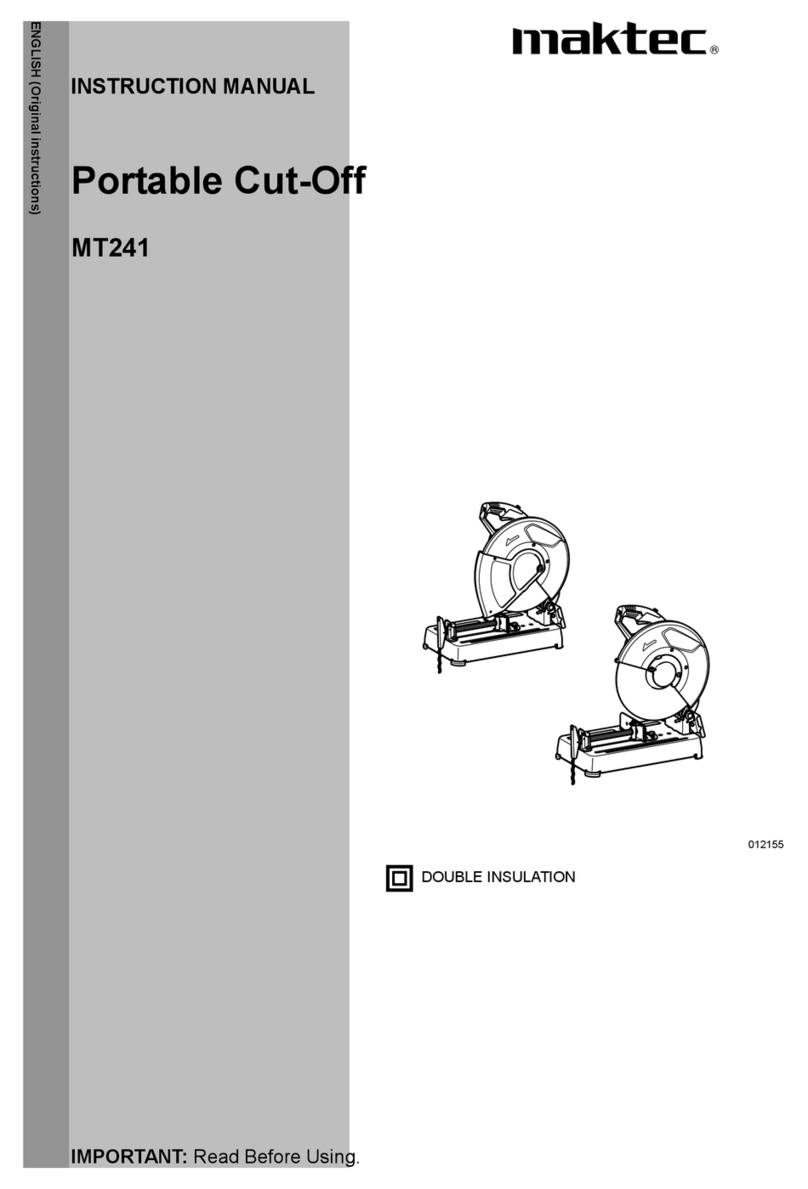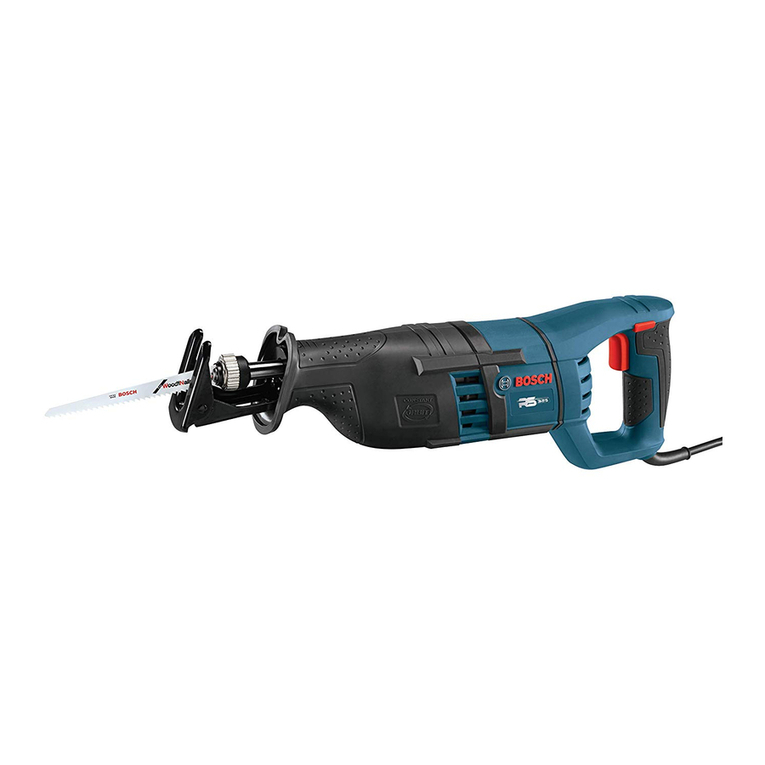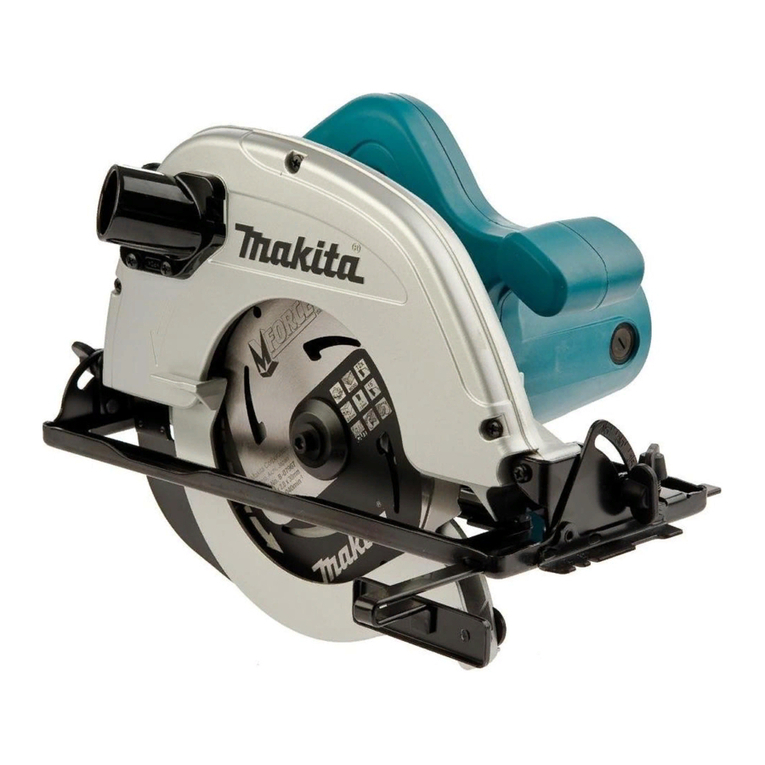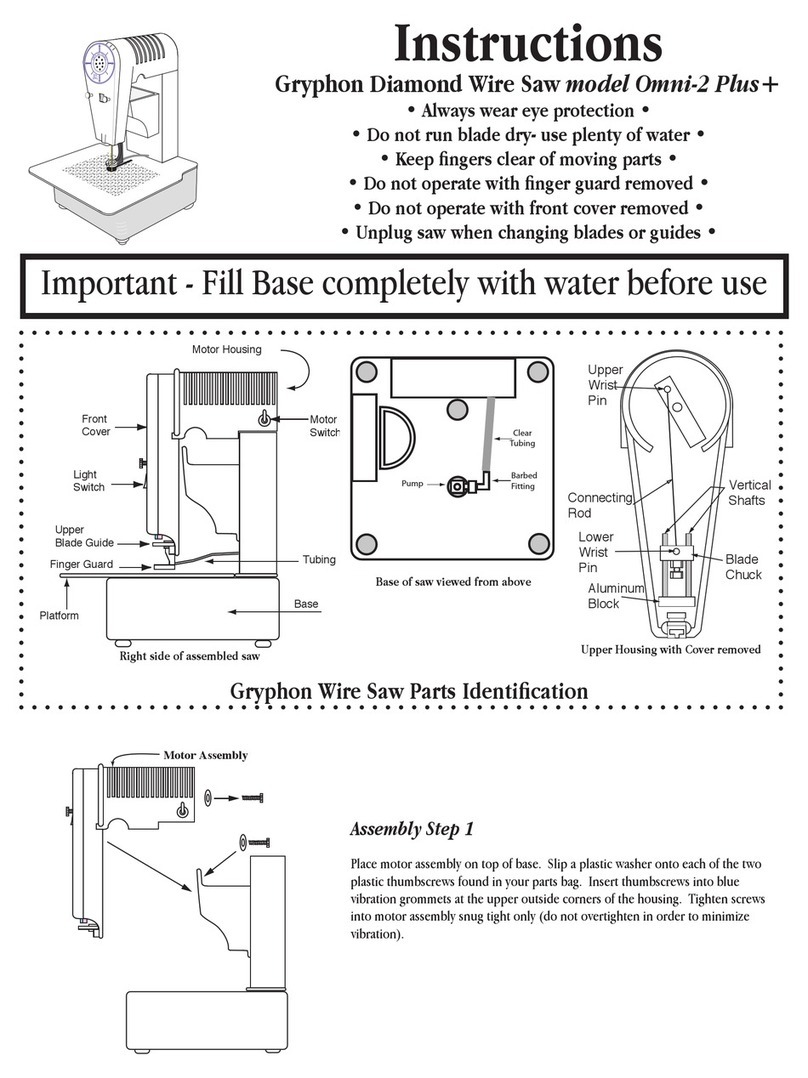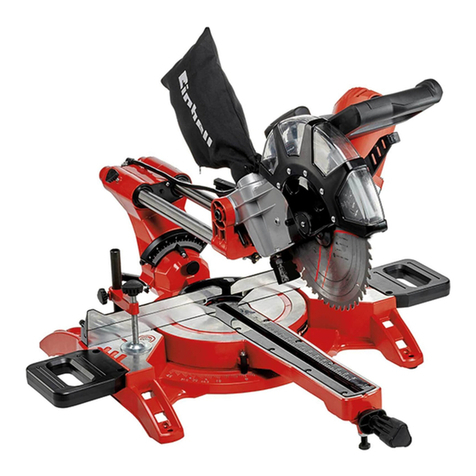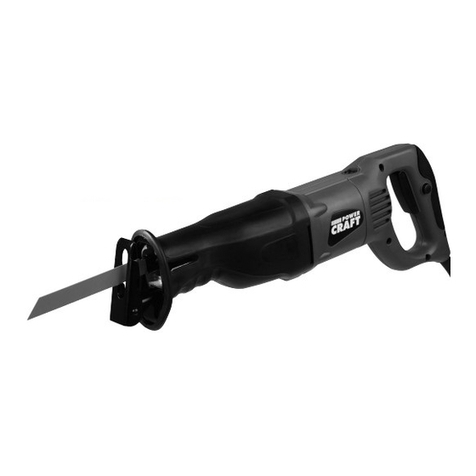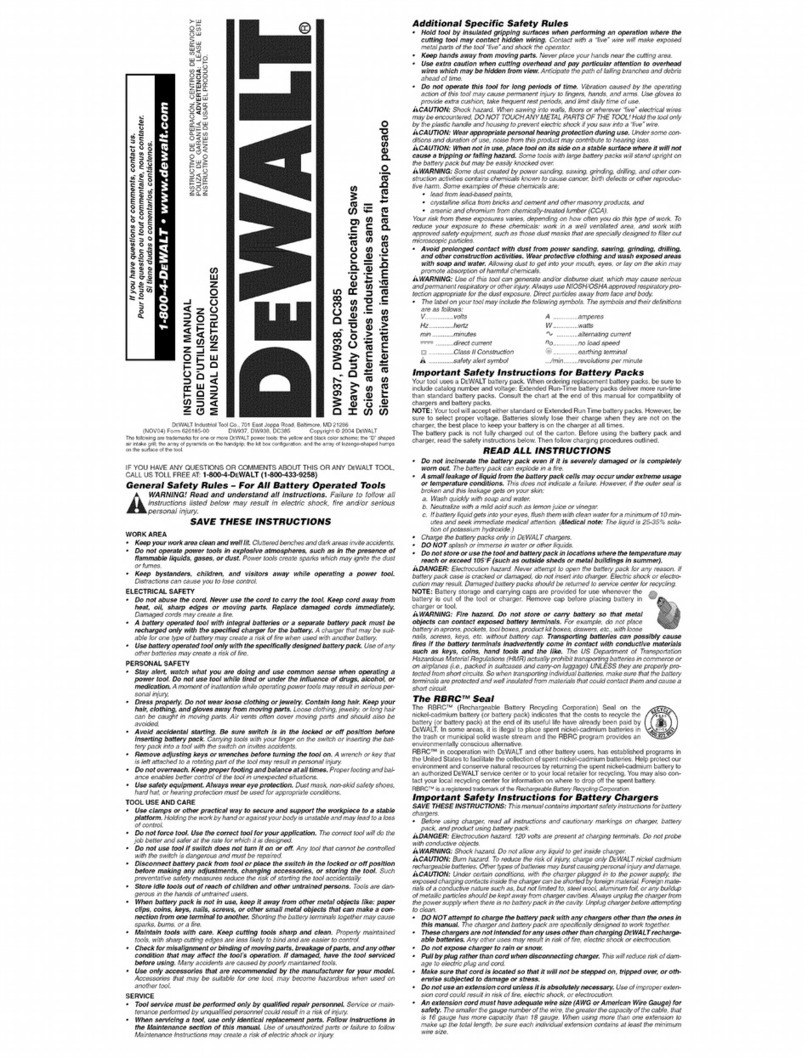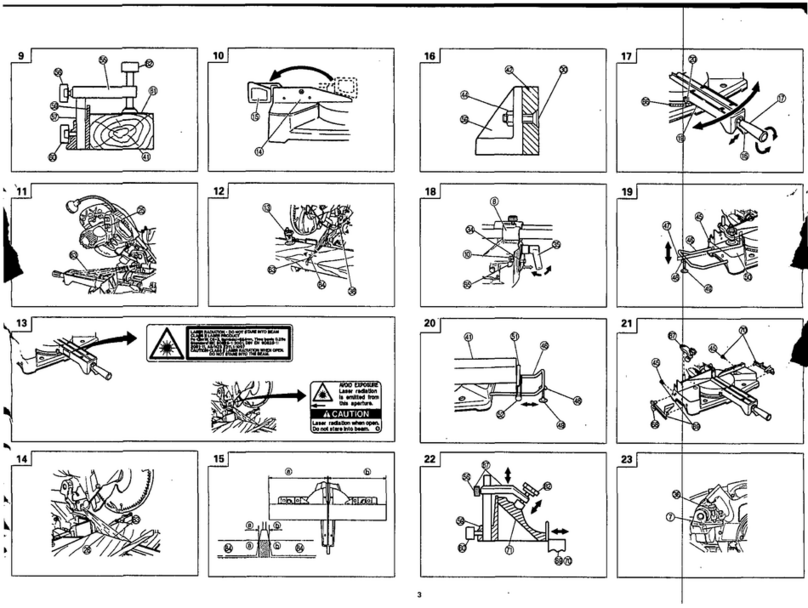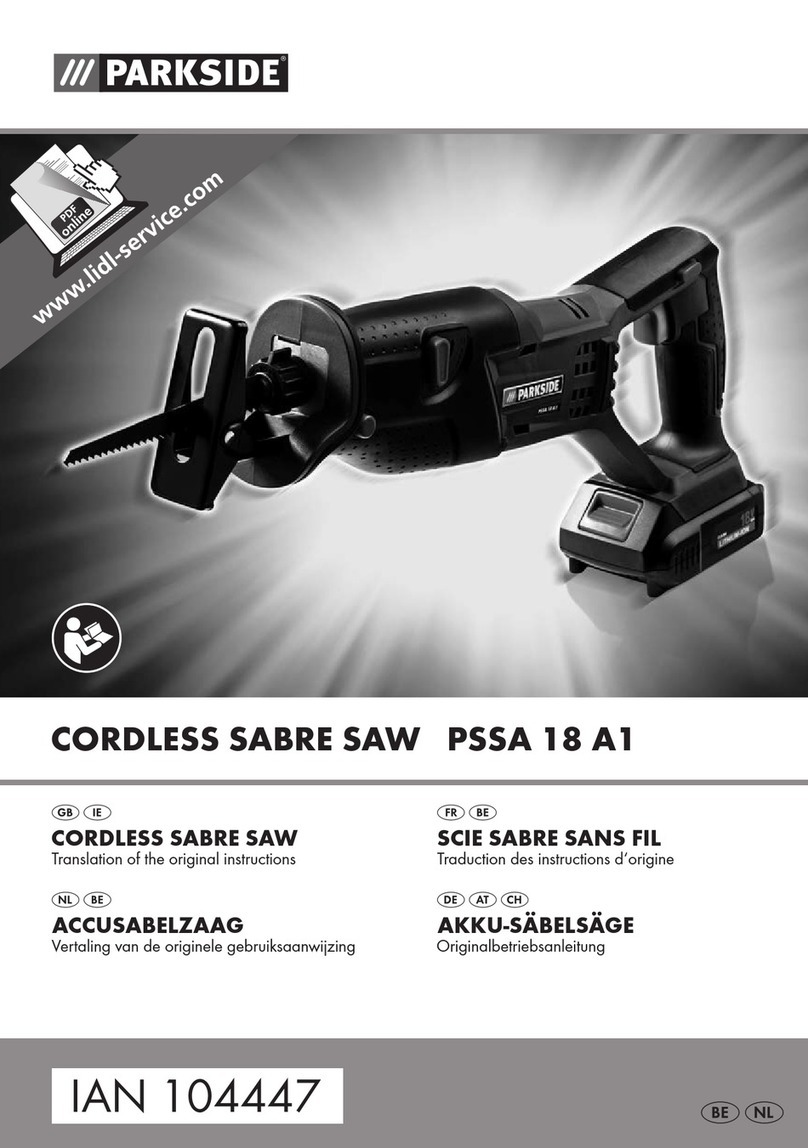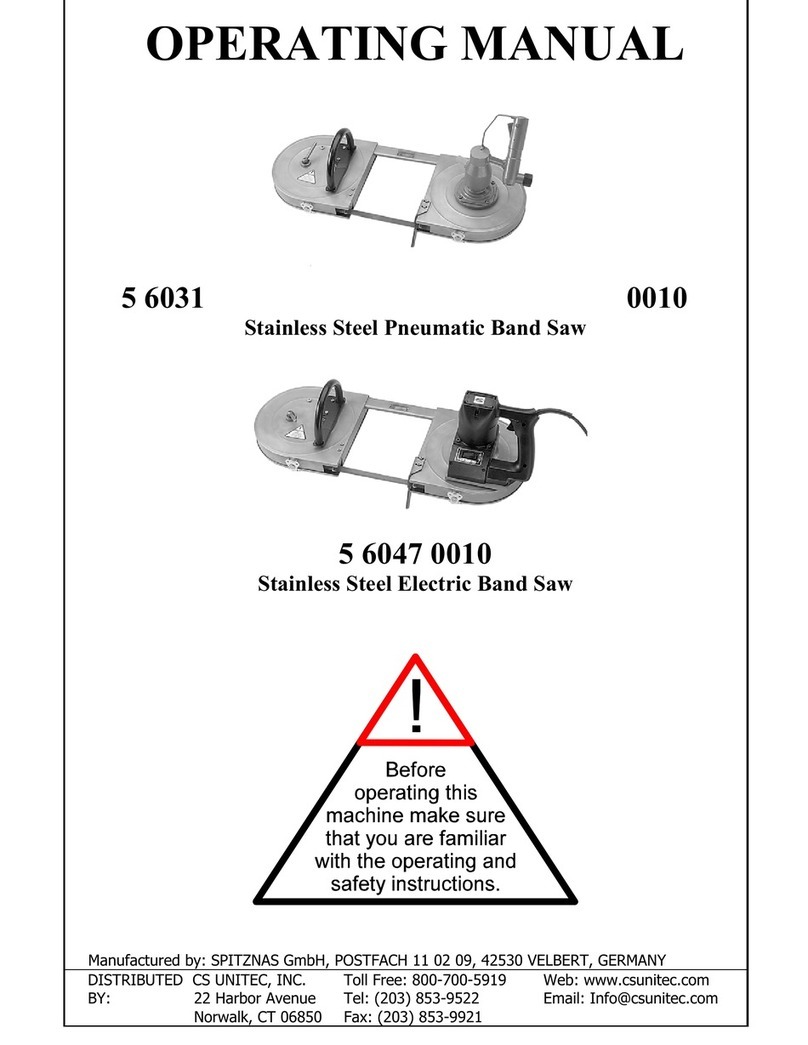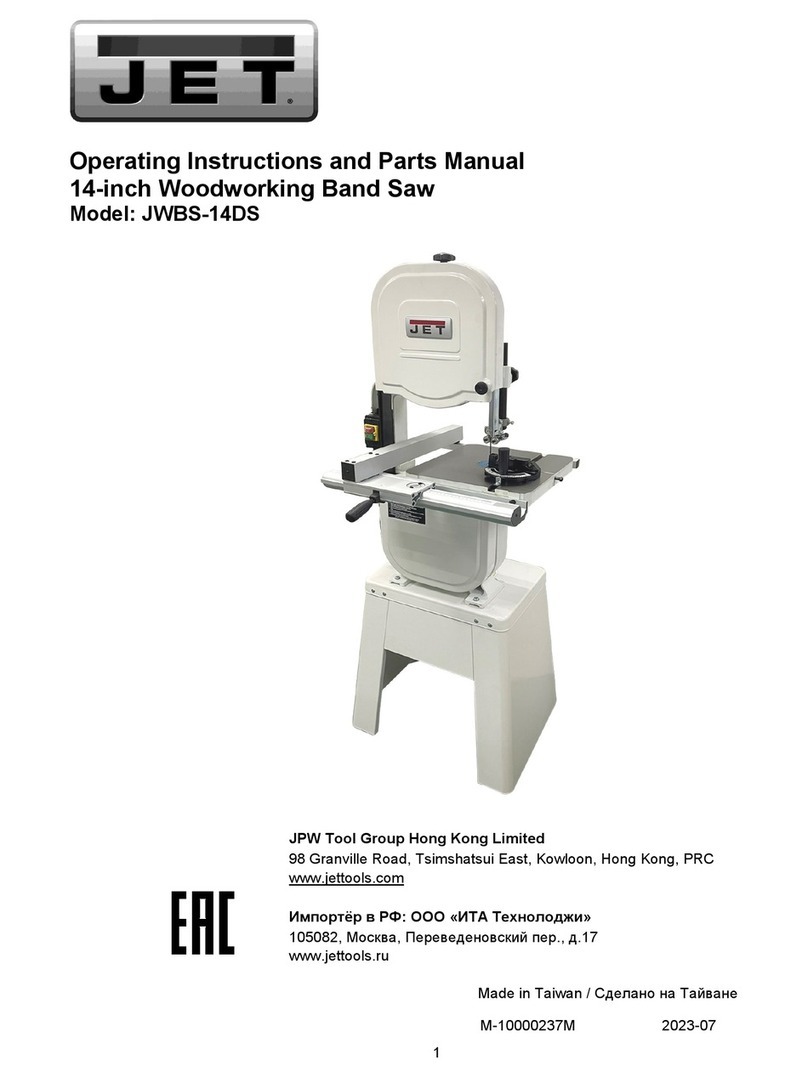Maktec MT450T User manual

GB Recipro Saw Instruction manual
ID Gergaji Bolak-Balik Petunjuk penggunaan
VI Maùy Cöa Kieám Caàm Tay Hoaït Taøi lieäu höôùng daãn
Ñoäng Baèng Ñoäng Cô Ñieän
TH
MT450T
MT450
014369

2
1000114 2014348
3014349 4014350
5014351 6014352
7014353 8014347
A
12
B
21
34
5
67
8
9
10
11

3
9014346 10 014358
11 014354 12 001145
13 014355
11
12
13
14
8
10
15
16
17
18

4
ENGLISH (Original instructions)
Explanation of general view
SPECIFICATIONS
• Due to our continuing program of research and development, the specifications herein are subject to change without
notice.
• Specifications may differ from country to country.
• Weight according to EPTA-Procedure 01/2014
Symbols END201-7
The following show the symbols used for the equipment.
Be sure that you understand their meaning before use.
... Read instruction manual.
............. DOUBLE INSULATION
Intended use ENE021-1
The tool is intended for sawing wood, plastic, metal and
building materials with a strong impact. It is suitable for
straight and curved cutting.
Power supply ENF002-2
The tool should be connected only to a power supply of
the same voltage as indicated on the nameplate, and can
only be operated on single-phase AC supply. They are
double-insulated and can, therefore, also be used from
sockets without earth wire.
General power tool safety
warnings GEA012-2
WARNING: Read all safety warnings, instructions,
illustrations and specifications provided with this
power tool. Failure to follow all instructions listed below
may result in electric shock, fire and/or serious injury.
Save all warnings and
instructions for future reference.
The term “power tool” in the warnings refers to your
mains-operated (corded) power tool or battery-operated
(cordless) power tool.
Work area safety
1. Keep work area clean and well lit. Cluttered or dark
areas invite accidents.
2. Do not operate power tools in explosive
atmospheres, such as in the presence of
flammable liquids, gases or dust. Power tools
create sparks which may ignite the dust or fumes.
3. Keep children and bystanders away while
operating a power tool. Distractions can cause you
to lose control.
Electrical Safety
1. Power tool plugs must match the outlet. Never
modify the plug in any way. Do not use any
adapter plugs with earthed (grounded) power
tools. Unmodified plugs and matching outlets will
reduce risk of electric shock.
2. Avoid body contact with earthed or grounded
surfaces, such as pipes, radiators, ranges and
refrigerators. There is an increased risk of electric
shock if your body is earthed or grounded.
3. Do not expose power tools to rain or wet
conditions. Water entering a power tool will increase
the risk of electric shock.
4. Do not abuse the cord. Never use the cord for
carrying, pulling or unplugging the power tool.
Keep cord away from heat, oil, sharp edges or
moving parts. Damaged or entangled cords increase
the risk of electric shock.
5. When operating a power tool outdoors, use an
extension cord suitable for outdoor use. Use of a
cord suitable for outdoor use reduces the risk of
electric shock.
6. If operating a power tool in a damp location is
unavoidable, use a residual current device (RCD)
protected supply. Use of an RCD reduces the risk of
electric shock.
1. Shoe
2. Shoe button
3. Switch trigger
4. Lock button
5. Blade clamp sleeve
6. Fixed position
7. Released position
8. Blade
9. Blade clamp lever
10. Hex wrench
11. Screw
12. Pin
13. Blade clamp
14. Hole
15. Insulation cover
16. Limit mark
17. Brush holder cap
18. Screwdriver
Model MT450T MT450
Length of stroke 28 mm 28 mm
Max. cutting capacities Pipe 130 mm 130 mm
Wood 255 mm 255 mm
Strokes per minute (min-1) 0 - 2,800 0 - 2,800
Overall length 457 mm 457 mm
Net weight 3.2 kg 3.1 kg
Safety class /II

5
7. Use of power supply via an RCD with a rated
residual current of 30 mA or less is always
recommended.
8. Power tools can produce electromagnetic fields
(EMF) that are not harmful to the user. However,
users of pacemakers and other similar medical
devices should contact the maker of their device and/
or doctor for advice before operating this power tool.
9. Do not touch the power plug with wet hands.
10. If the cord is damaged, have it replaced by the
manufacturer or his agent in order to avoid a
safety hazard.
Personal Safety
1. Stay alert, watch what you are doing and use
common sense when operating a power tool. Do
not use a power tool while you are tired or under
the influence of drugs, alcohol or medication. A
moment of inattention while operating power tools
may result in serious personal injury.
2. Use personal protective equipment. Always wear
eye protection. Protective equipment such as a dust
mask, non-skid safety shoes, hard hat or hearing
protection used for appropriate conditions will reduce
personal injuries.
3. Prevent unintentional starting. Ensure the switch
is in the off-position before connecting to power
source and/or battery pack, picking up or carrying
the tool. Carrying power tools with your finger on the
switch or energising power tools that have the switch
on invites accidents.
4. Remove any adjusting key or wrench before
turning the power tool on. A wrench or a key left
attached to a rotating part of the power tool may result
in personal injury.
5. Do not overreach. Keep proper footing and
balance at all times. This enables better control of
the power tool in unexpected situations.
6. Dress properly. Do not wear loose clothing or
jewellery. Keep your hair and clothing away from
moving parts. Loose clothes, jewellery or long hair
can be caught in moving parts.
7. If devices are provided for the connection of dust
extraction and collection facilities, ensure these
are connected and properly used. Use of dust
collection can reduce dust-related hazards.
8. Do not let familiarity gained from frequent use of
tools allow you to become complacent and ignore
tool safety principles. A careless action can cause
severe injury within a fraction of a second.
9. Always wear protective goggles to protect your
eyes from injury when using power tools. The
goggles must comply with ANSI Z87.1 in the USA,
EN 166 in Europe, or AS/NZS 1336 in Australia/
New Zealand. In Australia/New Zealand, it is
legally required to wear a face shield to protect
your face, too. (Fig. 1)
It is an employer’s responsibility to enforce the
use of appropriate safety protective equipments
by the tool operators and by other persons in the
immediate working area.
Power tool use and care
1. Do not force the power tool. Use the correct power
tool for your application. The correct power tool will
do the job better and safer at the rate for which it was
designed.
2. Do not use the power tool if the switch does not
turn it on and off. Any power tool that cannot be
controlled with the switch is dangerous and must be
repaired.
3. Disconnect the plug from the power source and/or
remove the battery pack, if detachable, from the
power tool before making any adjustments,
changing accessories, or storing power tools.
Such preventive safety measures reduce the risk of
starting the power tool accidentally.
4. Store idle power tools out of the reach of children
and do not allow persons unfamiliar with the
power tool or these instructions to operate the
power tool. Power tools are dangerous in the hands
of untrained users.
5. Maintain power tools and accessories. Check for
misalignment or binding of moving parts,
breakage of parts and any other condition that
may affect the power tool’s operation. If damaged,
have the power tool repaired before use. Many
accidents are caused by poorly maintained power
tools.
6. Keep cutting tools sharp and clean. Properly
maintained cutting tools with sharp cutting edges are
less likely to bind and are easier to control.
7. Use the power tool, accessories and tool bits etc.
in accordance with these instructions, taking into
account the working conditions and the work to
be performed. Use of the power tool for operations
different from those intended could result in a
hazardous situation.
8. Keep handles and grasping surfaces dry, clean
and free from oil and grease. Slippery handles and
grasping surfaces do not allow for safe handling and
control of the tool in unexpected situations.
9. When using the tool, do not wear cloth work
gloves which may be entangled. The entanglement
of cloth work gloves in the moving parts may result in
personal injury.
Service
1. Have your power tool serviced by a qualified
repair person using only identical replacement
parts. This will ensure that the safety of the power tool
is maintained.
2. Follow instruction for lubricating and changing
accessories.
Recipro saw safety warnings
GEB164-1
1. Hold the power tool by insulated gripping
surfaces, when performing an operation where the
cutting accessory may contact hidden wiring or its
own cord. Cutting accessory contacting a “live” wire
may make exposed metal parts of the power tool “live”
and could give the operator an electric shock.
2. Use clamps or another practical way to secure and
support the workpiece to a stable platform. Holding
the workpiece by hand or against your body leaves it
unstable and may lead to loss of control.
3. Always use safety glasses or goggles. Ordinary
eye or sun glasses are NOT safety glasses.

6
4. Avoid cutting nails. Inspect workpiece for any
nails and remove them before operation.
5. Do not cut oversize workpiece.
6. Check for the proper clearance beyond the
workpiece before cutting so that the blade will not
strike the floor, workbench, etc.
7. Hold the tool firmly.
8. Make sure the blade is not contacting the
workpiece before the switch is turned on.
9. Keep hands away from moving parts.
10. Do not leave the tool running. Operate the tool
only when hand-held.
11. Always switch off and wait for the blade to come
to a complete stop before removing the blade from
the workpiece.
12. Do not touch the blade or the workpiece
immediately after operation; they may be
extremely hot and could burn your skin.
13. Do not operate the tool at no-load unnecessarily.
14. Always use the correct dust mask/respirator for
the material and application you are working with.
15. Some material contains chemicals which may be
toxic. Take caution to prevent dust inhalation and
skin contact. Follow material supplier safety data.
SAVE THESE INSTRUCTIONS.
WARNING:
DO NOT let comfort or familiarity with product (gained
from repeated use) replace strict adherence to safety
rules for the subject product. MISUSE or failure to
follow the safety rules stated in this instruction
manual may cause serious personal injury.
FUNCTIONAL DESCRIPTION
CAUTION:
• Always be sure that the tool is switched off and
unplugged before adjusting or checking function on the
tool.
Adjusting the shoe (Fig. 2 & 3)
When the blade loses its cutting efficiency in one place
along its cutting edge, reposition the shoe to utilize a
sharp, unused portion of its cutting edge. This will help to
lengthen the life of the blade. To reposition the shoe, push
the shoe button in the “A” direction with a click and
reposition as shown in the figure which allows you to
make five-way adjustment. To secure the shoe, push the
shoe button in the “B” direction with a click.
Switch action
CAUTION:
• Before plugging in the tool, always check to see that
the switch trigger actuates properly and returns to the
“OFF” position when released.
• Switch can be locked in “ON” position for ease of
operator comfort during extended use. Apply caution
when locking tool in “ON” position and maintain firm
grasp on tool. (Fig. 4)
To start the tool, simply pull the switch trigger. Tool speed
is increased by increasing pressure on the switch trigger.
Release the switch trigger to stop.
For continuous operation, pull the switch trigger, push in
the lock button and then release the switch trigger.
To stop the tool from the locked position, pull the switch
trigger fully, then release it.
ASSEMBLY
CAUTION:
• Always be sure that the tool is switched off and
unplugged before carrying out any work on the tool.
Installing or removing the saw blade for
Model MT450T
CAUTION:
• Always clean out all chips or foreign matter adhering to
the blade, blade clamp and/or slider. Failure to do so
may cause insufficient tightening of the blade, resulting
in a serious injury. (Fig. 5)
To install the saw blade, always make sure that the blade
clamp lever is in released position on the insulation
cover before inserting the saw blade. If the blade clamp
lever is in fixed position, rotate the blade clamp lever in
the direction of the arrow so that it can be locked at the
released position .
CAUTION:
• If you do not insert the saw blade deep enough, the
saw blade may be ejected unexpectedly during
operation. This can be extremely dangerous.
• Keep hands and fingers away from the lever during the
switching operation. Failure to do so may cause
personal injuries. (Fig. 6)
Insert the saw blade into the blade clamp as far as it will
go. The blade clamp lever rotates and the saw blade is
fixed. Make sure that the saw blade cannot be extracted
even though you try to pull it out. (Fig. 7)
To remove the saw blade, rotate the blade clamp lever in
the direction of the arrow fully. The saw blade is removed
and the blade clamp lever is fixed at the released
position .
NOTE:
• If you remove the saw blade without rotating the blade
clamp lever fully, the lever may not be locked in the
released position . In this case, rotate the blade
clamp lever fully again, then make sure that the blade
clamp lever locked at the released position .
• If the lever is positioned inside the tool, switch on the
tool just a second to let the blade clamp out. Switch off
and unplug the tool from the mains before working on
the blade clamp lever.
Installing or removing the saw blade for
Model MT450
CAUTION:
• Always clean out all chips or foreign matter adhering to
the blade, blade clamp and/or slider. Failure to do so
may cause insufficient tightening of the blade, resulting
in a serious injury. (Fig. 8)
To install the blade, loosen the screw on the blade clamp
with the hex wrench. Insert the blade between the blade
clamp and the slider so that the pin on the slider fits into
the hole in the blade shank. If the pin cannot easily fit into

7
the hole, remove the hex wrench from the screw and then
try again.
CAUTION:
• If you tighten the screw without the pin on the slider
fitting properly in the hole in the blade shank, the pin or
the blade shank will be damaged. This may cause the
blade to be extracted unexpectedly during operation.
(Fig. 9)
After the pin fits properly into the hole, tighten the screw
clockwise securely. Make sure that the blade cannot be
extracted even though you try to pull it out.
To remove the blade, follow the installation procedure in
reverse.
Hex wrench storage (Fig. 10)
When not in use, store the hex wrench as shown in the
figure to keep it from being lost.
OPERATION
CAUTION:
• Always hold the tool firmly with one hand on insulation
cover and the other on the switch handle.
• Always press the shoe firmly against the workpiece
during operation. If the shoe is removed or held away
from the workpiece during operation, strong vibration
and/or twisting will be produced, causing the blade to
snap dangerously.
• Always wear gloves to protect your hands from hot
flying chips when cutting metal.
• Be sure to always wear suitable eye protection which
conforms with current national standards.
• Always use a suitable coolant (cutting oil) when cutting
metal. Failure to do so will cause premature blade
wear. (Fig. 11)
Press the shoe firmly against the workpiece. Do not allow
the tool to bounce. Bring the blade into light contact with
the workpiece. First, make a pilot groove using a slower
speed. Then use a faster speed to continue cutting.
MAINTENANCE
CAUTION:
• Always be sure that the tool is switched off and
unplugged before attempting to perform inspection or
maintenance.
• Never use gasoline, benzine, thinner, alcohol or the
like. Discoloration, deformation or cracks may result.
Replacing carbon brushes (Fig. 12)
Remove and check the carbon brushes regularly. Replace
when they wear down to the limit mark. Keep the carbon
brushes clean and free to slip in the holders. Both carbon
brushes should be replaced at the same time. Use only
identical carbon brushes.
Use a screwdriver to remove the brush holder caps. Take
out the worn carbon brushes, insert the new ones and
secure the brush holder caps. (Fig. 13)
To maintain product SAFETY and RELIABILITY, repairs,
any other maintenance or adjustment should be
performed by Makita Authorized Service Centers, always
using Makita replacement parts.

8
BAHASA INDONESIA (Petunjuk Asli)
Penjelasan tampilan keseluruhan
SPESIFIKASI
• Karena kesinambungan program penelitian dan pengembangan kami, spesifikasi yang disebutkan di sini dapat
berubah tanpa pemberitahuan.
• Spesifikasi dapat berbeda dari satu negara ke negara lainnya.
• Berat menurut Prosedur EPTA 01/2014
Simbol-simbol END201-7
Berikut ini adalah simbol-simbol yang digunakan pada
mesin ini. Pastikan Anda mengerti makna masing-masing
simbol sebelum menggunakan mesin ini.
... Baca petunjuk penggunaan.
............. ISOLASI GANDA
Maksud penggunaan ENE021-1
Alat ini dimaksudkan untuk menggergaji kayu, plastik,
logam, dan bahan bangunan dengan tumbukan kuat. Alat
ini sesuai untuk pemotongan lurus dan melengkung.
Pasokan daya ENF002-2
Alat harus terhubung dengan pasokan daya listrik yang
bervoltase sama dengan yang tertera pada pelat nama,
dan hanya dapat dijalankan dengan listrik AC fase
tunggal. Alat ini diisolasi ganda dan oleh sebab itu dapat
dihubungkan dengan soket tanpa arde.
Peringatan keselamatan umum
mesin listrik GEA012-2
PERINGATAN: Bacalah semua peringatan
keselamatan, petunjuk, ilustrasi dan spesifikasi yang
disertakan bersama mesin listrik ini. Kelalaian untuk
mematuhi semua petunjuk yang tercantum di bawah ini
dapat menyebabkan sengatan listrik, kebakaran dan/atau
cedera serius.
Simpanlah semua peringatan dan
petunjuk untuk acuan di masa depan.
Istilah “mesin listrik” dalam semua peringatan mengacu
pada mesin listrik yang dijalankan dengan sumber listrik
jala-jala (berkabel) atau baterai (tanpa kabel).
Keselamatan tempat kerja
1. Jaga tempat kerja selalu bersih dan
berpenerangan cukup. Tempat kerja yang
berantakan dan gelap mengundang kecelakaan.
2. Jangan gunakan mesin listrik dalam lingkungan
yang mudah meledak, misalnya jika ada cairan,
gas, atau debu yang mudah menyala. Mesin listrik
menimbulkan bunga api yang dapat menyalakan debu
atau uap tersebut.
3. Jauhkan anak-anak dan orang lain saat
menggunakan mesin listrik. Bila perhatian terpecah,
anda dapat kehilangan kendali.
Keamanan Kelistrikan
1. Steker mesin listrik harus cocok dengan
stopkontak. Jangan sekali-kali mengubah steker
dengan cara apa pun. Jangan menggunakan
steker adaptor dengan mesin listrik terbumi
(dibumikan). Steker yang tidak diubah dan
stopkontak yang cocok akan mengurangi risiko
sengatan listrik.
2. Hindari sentuhan tubuh dengan permukaan
terbumi atau yang dibumikan seperti pipa,
radiator, kompor, dan kulkas. Risiko sengatan listrik
bertambah jika tubuh Anda terbumikan atau
dibumikan.
3. Jangan membiarkan mesin listrik kehujanan atau
kebasahan. Air yang masuk ke dalam mesin listrik
akan meningkatkan risiko sengatan listrik.
4. Jangan menyalahgunakan kabel. Jangan sekali-
kali menggunakan kabel untuk membawa,
menarik, atau mencabut mesin listrik dari
stopkontak. Jauhkan kabel dari panas, minyak,
1. Sepatu
2. Tombol sepatu
3. Picu sakelar
4. Tombol kunci
5. Selongsong klem bilah
6. Posisi terkunci
7. Posisi terlepas
8. Bilah gergaji
9. Tuas klem bilah
10. Kunci hex
11. Sekrup
12. Pasak
13. Klem bilah
14. Lubang
15. Penutup isolasi
16. Garis batas
17. Tutup borstel arang
18. Obeng
Model MT450T MT450
Panjang langkah 28 mm 28 mm
Kemampuan pemotongan
maks.
Pipa 130 mm 130 mm
Kayu 255 mm 255 mm
Langkah per menit (men-1) 0 - 2.800 0 - 2.800
Panjang keseluruhan 457 mm 457 mm
Berat bersih 3,2 kg 3,1 kg
Kelas keamanan /II

9
tepian tajam, atau bagian yang bergerak. Kabel yang
rusak atau kusut memperbesar risiko sengatan listrik.
5. Bila menggunakan mesin listrik di luar ruangan,
gunakan kabel ekstensi yang sesuai untuk
penggunaan di luar ruangan. Penggunaan kabel
yang sesuai untuk penggunaan luar ruangan
mengurangi risiko sengatan listrik.
6. Jika mengoperasikan mesin listrik di lokasi
lembap tidak terhindarkan, gunakan pasokan daya
yang dilindungi peranti imbasan arus (residual
current device - RCD). Penggunaan RCD
mengurangi risiko sengatan listrik.
7. Penggunaan pasokan daya melalui RCD dengan
kapasitas arus sisa 30 mA atau kurang selalu
dianjurkan.
8. Mesin listrik dapat menghasilkan medan magnet
(EMF) yang tidak berbahaya bagi pengguna.
Namun, pengguna alat pacu jantung atau peralatan
medis sejenisnya harus berkonsultasi dengan
produsen peralatan tersebut dan/atau dokter mereka
sebelum mengoperasikan mesin listrik ini.
9. Jangan menyentuh colokan daya dengan tangan
basah.
10. Jika kabel rusak, penggantian harus dilakukan
oleh produsen atau agennya untuk menghindari
bahaya keselamatan.
Keselamatan Diri
1. Jaga kewaspadaan, perhatikan pekerjaan Anda
dan gunakan akal sehat bila menggunakan mesin
listrik. Jangan menggunakan mesin listrik saat
Anda lelah atau di bawah pengaruh obat bius,
alkohol, atau obat. Sekejap saja lalai saat
menggunakan mesin listrik dapat menyebabkan
cedera badan serius.
2. Gunakan alat pelindung diri. Selalu gunakan
pelindung mata. Peralatan pelindung seperti masker
debu, sepatu pengaman anti-selip, helm pengaman,
atau pelindung telinga yang digunakan untuk kondisi
yang sesuai akan mengurangi risiko cedera badan.
3. Cegah penyalaan yang tidak disengaja. Pastikan
bahwa sakelar berada dalam posisi mati (off)
sebelum menghubungkan mesin ke sumber daya
dan/atau paket baterai, atau mengangkat atau
membawanya. Membawa mesin listrik dengan jari
Anda pada sakelarnya atau mengalirkan listrik pada
mesin listrik yang sakelarnya hidup (on) akan
mengundang kecelakaan.
4. Lepaskan kunci-kunci penyetel sebelum
menghidupkan mesin listrik. Kunci-kunci yang
masih terpasang pada bagian mesin listrik yang
berputar dapat menyebabkan cedera.
5. Jangan meraih terlalu jauh. Jagalah pijakan dan
keseimbangan sepanjang waktu. Hal ini
memungkinkan kendali yang lebih baik atas mesin
listrik dalam situasi yang tidak diharapkan.
6. Kenakan pakaian yang memadai. Jangan memakai
pakaian yang longgar atau perhiasan. Jaga jarak
antara rambut dan pakaian Anda dengan
komponen mesin yang bergerak. Pakaian yang
longgar, perhiasan, atau rambut yang panjang dapat
tersangkut pada komponen yang bergerak.
7. Jika tersedia fasilitas untuk menghisap dan
mengumpulkan debu, pastikan fasilitas tersebut
terhubung listrik dan digunakan dengan baik.
Penggunaan pembersih debu dapat mengurangi
bahaya yang terkait dengan debu.
8. Jangan sampai Anda lengah dan mengabaikan
prinsip keselamatan mesin ini hanya karena
sudah sering mengoperasikannya dan sudah
merasa terbiasa. Tindakan yang lalai dapat
menyebabkan cedera berat dalam sepersekian detik
saja.
9. Selalu kenakan kacamata pelindung untuk
melindungi mata dari cedera saat menggunakan
mesin listrik. Kacamata harus sesuai dengan ANSI
Z87.1 di Amerika Serikat, EN 166 di Eropa, atau
AS/NZS 1336 di Australia/Selandia Baru. Di
Australia/Selandia Baru, secara hukum Anda juga
diwajibkan mengenakan pelindung wajah untuk
melindungi wajah Anda. (Gb. 1)
Menjadi tanggung jawab atasan untuk
menerapkan penggunaan alat pelindung
keselamatan yang tepat bagi operator mesin dan
orang lain yang berada di area kerja saat itu.
Penggunaan dan pemeliharaan mesin listrik
1. Jangan memaksa mesin listrik. Gunakan mesin
listrik yang tepat untuk keperluan Anda. Mesin
listrik yang tepat akan menuntaskan pekerjaan
dengan lebih baik dan aman pada kecepatan sesuai
rancangannya.
2. Jangan gunakan mesin listrik jika sakelar tidak
dapat menyalakan dan mematikannya. Mesin listrik
yang tidak dapat dikendalikan dengan sakelarnya
adalah berbahaya dan harus diperbaiki.
3. Cabut steker dari sumber listrik dan/atau lepas
paket baterai, jika dapat dilepas, dari mesin listrik
sebelum melakukan penyetelan apa pun,
mengganti aksesori, atau menyimpan mesin
listrik. Langkah keselamatan preventif tersebut
mengurangi risiko hidupnya mesin secara tak
sengaja.
4. Simpan mesin listrik jauh dari jangkauan anak-
anak dan jangan biarkan orang yang tidak paham
mengenai mesin listrik tersebut atau petunjuk ini
menggunakan mesin listrik. Mesin listrik sangat
berbahaya di tangan pengguna yang tak terlatih.
5. Rawatlah mesin listrik dan aksesori. Periksa
apakah ada komponen bergerak yang tidak lurus
atau macet, komponen yang pecah, dan kondisi-
kondisi lain yang dapat memengaruhi
pengoperasian mesin listrik. Jika rusak, perbaiki
dahulu mesin listrik sebelum digunakan. Banyak
kecelakaan disebabkan oleh kurangnya pemeliharaan
mesin listrik.
6. Jaga agar mesin pemotong tetap tajam dan bersih.
Mesin pemotong yang terawat baik dengan mata
pemotong yang tajam tidak mudah macet dan lebih
mudah dikendalikan.
7. Gunakan mesin listrik, aksesori, dan mata mesin,
dll. sesuai dengan petunjuk ini, dengan
memperhitungkan kondisi kerja dan jenis
pekerjaan yang dilakukan. Penggunaan mesin listrik
untuk penggunaan yang lain dari peruntukan dapat
menimbulkan situasi berbahaya.
8. Jagalah agar gagang dan permukaan pegangan
tetap kering, bersih, dan bebas dari minyak dan
pelumas. Gagang dan permukaan pegangan yang

10
licin tidak mendukung keamanan penanganan dan
pengendalian mesin dalam situasi-situasi tak terduga.
9. Ketika menggunakan mesin, jangan
menggunakan sarung tangan kain yang dapat
tersangkut. Sarung tangan kain yang tersangkut
pada komponen bergerak dapat mengakibatkan
cedera pada pengguna.
Servis
1. Berikan mesin listrik untuk diperbaiki hanya
kepada oleh teknisi yang berkualifikasi dengan
menggunakan hanya suku cadang pengganti yang
serupa. Hal ini akan menjamin terjaganya keamanan
mesin listrik.
2. Patuhi petunjuk pelumasan dan penggantian
aksesori.
Peringatan keselamatan gergaji
reciprocating GEB164-1
1. Pegang mesin listrik pada permukaan genggam
yang terisolasi saat melakukan pekerjaan bila
mesin pemotong mungkin bersentuhan dengan
kawat tersembunyi atau kabelnya sendiri. Aksesori
pemotong yang menyentuh kawat “hidup” dapat
menyebabkan bagian logam pada mesin teraliri arus
listrik dan menyengat pengguna.
2. Gunakan klem atau cara praktis lainnya untuk
mengikat dan menahan benda kerja pada posisi
yang stabil. Menahan benda kerja dengan tangan
atau berada pada posisi berlawanan dengan badan
Anda membuat benda kerja tidak stabil dan dapat
menyebabkan kehilangan kendali.
3. Selalu gunakan kaca mata pengaman atau kaca
mata pelindung. Kaca mata biasa atau kaca mata
hitam BUKANLAH kaca mata pengaman.
4. Hindari memotong paku. Periksa apakah terdapat
paku di benda kerja dan buang semua paku
sebelum pengoperasian.
5. Jangan memotong benda kerja terlalu besar.
6. Periksa apakah jarak di luar benda kerja sudah
tepat sebelum memotong sehingga mata pisau
tidak akan menabrak lantai, meja kerja, dll.
7. Pegang mesin kuat-kuat.
8. Pastikan bahwa mata pisau tidak menyentuh
benda kerja sebelum sakelar dinyalakan.
9. Jauhkan tangan dari bagian yang berputar.
10. Jangan tinggalkan mesin dalam keadaan hidup.
Jalankan mesin hanya ketika digenggam tangan.
11. Selalu matikan dan tunggu sampai mata pisau
benar-benar berhenti sebelum melepas mata
pisau dari benda kerja.
12. Jangan menyentuh mata pisau atau benda kerja
segera setelah pengoperasian; suhunya mungkin
masih sangat panas dan dapat membakar kulit
Anda.
13. Jangan mengoperasikan mesin tanpa beban
dengan tanpa keperluan.
14. Selalu gunakan masker debu/alat pernafasan yang
tepat sesuai bahan dan pekerjaan yang sedang
Anda kerjakan.
15. Bahan tertentu mengandung zat kimia yang
mungkin beracun. Hindari menghirup debu dan
persentuhan dengan kulit. Ikuti data keselamatan
bahan dari pemasok.
SIMPAN PETUNJUK INI.
PERINGATAN:
JANGAN biarkan kenyamanan atau terbiasanya Anda
dengan produk (karena penggunaan berulang)
mengurangi kepatuhan yang ketat terhadap aturan
keselamatan untuk produk yang terkait.
PENYALAHGUNAAN atau kelalaian mematuhi kaidah
keselamatan yang tertera dalam petunjuk ini dapat
menyebabkan cedera badan serius.
DESKRIPSI FUNGSI
PERHATIAN:
• Selalu pastikan alat sudah dimatikan dan stekernya
dicabut sebelum menyetel atau memeriksa fungsi alat.
Menyetel sepatu (Gb. 2 & 3)
Ketika bilah kehilangan efisiensi pemotongan di satu
tempat pada mata pemotongnya, posisikan ulang sepatu
guna memanfaatkan bagian mata pemotong yang belum
digunakan dan masih tajam. Ini akan membantu
memperpanjang usia pakai bilah. Untuk mengubah posisi
sepatu, tekan tombol sepatu ke arah “A” dengan satu klik
dan posisikan ulang seperti terlihat dalam gambar, yang
memungkinkan Anda melakukan penyesuaian lima arah.
Untuk mengencangkan sepatu, tekan tombol sepatu ke
arah “B” dengan satu klik.
Gerakan sakelar
PERHATIAN:
• Sebelum menancapkan steker alat, selalu pastikan
bahwa picu sakelar bekerja dengan baik dan kembali
ke posisi “OFF” (MATI) saat dilepaskan.
• Sakelar dapat dikunci pada posisi “ON” (HIDUP) untuk
memudahkan pengguna saat menggunakan alat dalam
waktu lama. Hati-hatilah saat mengunci alat dalam
posisi “ON” (HIDUP) dan genggam alat kuat-kuat
setiap saat. (Gb. 4)
Untuk menyalakan alat, cukup tarik picu sakelarnya.
Kecepatan alat akan meningkat sejalan dengan semakin
kerasnya picu sakelar ditekan. Lepaskan picu sakelar
untuk menghentikannya.
Untuk pengoperasian terus-menerus, tarik picu sakelar,
tekan masuk tombol kunci, lalu lepaskan picu sakelar.
Untuk menghentikan alat dari posisi terkunci, tarik picu
sakelar sepenuhnya, kemudian lepaskan.
PERAKITAN
PERHATIAN:
• Selalu pastikan alat sudah dimatikan dan stekernya
dicabut sebelum melakukan pekerjaan apa pun pada
alat.
Memasang atau melepas bilah gergaji
untuk Model MT450T
PERHATIAN:
• Selalu bersihkan semua serpihan atau benda asing
yang menempel pada bilah, klem bilah, dan/atau

11
penggeser. Kelalaian untuk melakukan ini dapat
menyebabkan bilah terpasang kurang kencang,
sehingga mengakibatkan cedera serius. (Gb. 5)
Untuk memasang bilah gergaji, selalu pastikan bahwa
tuas klem bilah berada dalam posisi terlepas pada
penutup isolasi sebelum memasukkan bilah gergaji. Jika
tuas klem bilah berada dalam posisi terkunci, putar tuas
klem bilah sesuai arah tanda panah sehingga tuas dapat
dikunci pada posisi terlepas .
PERHATIAN:
• Jika Anda tidak memasukkan bilah gergaji cukup
dalam, bilah gergaji dapat terdorong keluar secara tak
terduga saat digunakan. Kondisi ini dapat sangat
berbahaya.
• Jauhkan tangan dan jari dari tuas selama penggantian
bilah. Kelalaian untuk melakukan hal ini dapat
menyebabkan cedera. (Gb. 6)
Masukkan bilah gergaji ke dalam klem bilah sejauh dapat
masuk. Tuas klem bilah berputar dan bilah gergaji
terkunci. Pastikan bahwa bilah gergaji tidak dapat
terlepas meskipun Anda mencoba menariknya keluar.
(Gb. 7)
Untuk melepas bilah gergaji, putar tuas klem bilah sesuai
arah tanda panah sepenuhnya. Bilah gergaji terlepas dan
tuas klem bilah terkunci pada posisi terlepas .
CATATAN:
• Jika Anda melepas bilah gergaji tanpa memutar tuas
klem bilah sepenuhnya, tuas dapat tidak terkunci
dalam posisi terlepas . Dalam kondisi demikian, putar
tuas klem bilah sepenuhnya lagi, kemudian pastikan
bahwa tuas klem bilah terkunci pada posisi terlepas .
• Jika tuas berada di dalam alat, hidupkan alat selama
satu detik saja untuk membiarkan klem bilah keluar.
Matikan dan cabut steker alat dari stopkontak listrik
sebelum menangani tuas klem bilah.
Memasang atau melepas bilah gergaji
untuk Model MT450
PERHATIAN:
• Selalu bersihkan semua serpihan atau benda asing
yang menempel pada bilah, klem bilah, dan/atau
penggeser. Kelalaian untuk melakukan ini dapat
menyebabkan bilah terpasang kurang kencang,
sehingga mengakibatkan cedera serius. (Gb. 8)
Untuk memasang bilah, kendurkan sekrup pada klem
bilah dengan kunci hex. Masukkan bilah di antara klem
bilah dan penggeser sehingga pasak pada penggeser
terpasang pas dalam lubang pada tangkai bilah. Jika
pasak tidak bisa masuk dengan mudah ke dalam lubang,
lepaskan kunci hex dari sekrup, lalu coba lagi.
PERHATIAN:
• Jika Anda mengencangkan sekrup ketika pasak pada
penggeser belum terpasang dengan benar ke dalam
lubang pada tangkai bilah, pasak atau tangkai bilah
akan rusak. Hal ini dapat menyebabkan bilah tercabut
secara tak terduga saat gergaji digunakan. (Gb. 9)
Setelah pasak terpasang dengan benar ke dalam lubang,
kencangkan sekrupnya searah jarum jam hingga
kencang. Pastikan bahwa bilah tidak dapat tercabut
meskipun Anda mencoba menariknya keluar.
Untuk melepas bilah, ikuti prosedur pemasangan secara
terbalik.
Penyimpanan kunci hex (Gb. 10)
Bila tidak sedang digunakan, simpanlah kunci hex seperti
terlihat dalam gambar agar tidak hilang.
PENGOPERASIAN
PERHATIAN:
• Selalu pegang alat kuat-kuat dengan satu tangan pada
penutup isolasi dan tangan lainnya pada gagang
sakelar.
• Selalu tekankan sepatu alat kuat-kuat pada benda
kerja selama mengoperasikan. Jika sepatu dilepas
atau ditahan tidak menempel pada benda kerja selama
pengoperasian, getaran yang kuat dan/atau
pemuntiran akan terjadi, sehingga menyebabkan bilah
mencelat dan menimbulkan bahaya.
• Selalu kenakan sarung tangan untuk melindungi
tangan Anda dari serpihan panas yang beterbangan
saat memotong logam.
• Pastikan untuk selalu mengenakan pelindung mata
yang sesuai yang memenuhi standar nasional yang
berlaku.
• Selalu gunakan cairan pendingin yang sesuai (oli
pemotongan) saat memotong logam. Kelalaian untuk
melakukan ini akan menyebabkan keausan bilah
secara dini. (Gb. 11)
Tekankan sepatu kuat-kuat pada benda kerja. Jangan
biarkan alat memantul. Tempelkan bilah gergaji sedikit
saja dulu pada benda kerja. Pertama, buatlah alur rintisan
menggunakan kecepatan rendah. Kemudian gunakan
kecepatan yang lebih tinggi untuk meneruskan
pemotongan.
PERAWATAN
PERHATIAN:
• Selalu pastikan alat sudah dimatikan dan stekernya
dicabut sebelum melakukan pemeriksaan atau
perawatan.
• Jangan sekali-kali menggunakan bensin, tiner, alkohol,
atau bahan sejenisnya. Penggunaan bahan demikian
dapat menyebabkan perubahan warna dan bentuk
serta timbulnya retakan.
Mengganti borstel arang (Gb. 12)
Lepaskan dan periksa borstel arang secara teratur. Ganti
bila borstel sudah aus mencapai garis batas. Jaga agar
borstel arang tetap bersih dan masuk lancar ke
tempatnya. Kedua borstel arang harus diganti secara
bersamaan. Gunakan hanya borstel arang yang identik.
Gunakan obeng untuk melepas tutup borstel arang.
Lepaskan borstel arang yang sudah aus, masukkan
borstel arang baru, dan kencangkan tutup borstel arang.
(Gb. 13)
Untuk menjaga KEAMANAN dan KEHANDALAN,
perbaikan, perawatan atau penyetelan lain harus
dilakukan oleh Pusat Servis Resmi Makita dan gunakan
selalu suku cadang Makita.

12
TIEÁNG VIEÄT (Höôùng daãn Goác)
Giaûi thích veà hình veõ toång theå
THOÂNG SOÁ KYÕ THUAÄT
•Do chöông trình nghieân cöùu vaø phaùt trieån lieân tuïc cuûa chuùng toâi neân caùc thoâng soá kyõ thuaät döôùi ñaây coù theå thay
ñoåi maø khoâng caàn thoâng baùo.
•Caùc thoâng soá kyõ thuaät ôû moãi quoác gia coù theå khaùc nhau.
•Troïng löôïng theo quy ñònh EPTA-Procedure 01/2014
Kyù hieäu END201-7
Phaàn döôùi ñaây cho bieát caùc kyù hieäu ñöôïc duøng cho
thieát bò. Ñaûm baûo raèng baïn hieåu yù nghóa cuûa caùc kyù
hieäu naøy tröôùc khi söû duïng.
... Ñoïc taøi lieäu höôùng daãn.
............ CAÙCH ÑIEÄN KEÙP
Muïc ñích söû duïng ENE021-1
Duïng cuï naøy duøng ñeå cöa goã, nhöïa, kim loaïi vaø vaät
lieäu xaây döïng vôùi taùc ñoäng maïnh. Duïng cuï naøy phuø
hôïp ñeå cöa thaúng vaø cong.
Nguoàn caáp ñieän ENF002-2
Duïng cuï naøy chæ ñöôïc noái vôùi nguoàn caáp ñieän coù ñieän
aùp gioáng nhö ñaõ chæ ra treân bieån teân vaø chæ coù theå ñöôïc
vaän haønh treân nguoàn cung caáp AC moät pha. Thieát bò
ñöôïc caùch ñieän keùp vaø do ñoù cuõng coù theå ñöôïc söû
duïng töø caùc oå caém maø khoâng caàn daây tieáp ñaát.
Caûnh baùo an toaøn chung daønh
cho duïng cuï maùy GEA012-2
CAÛNH BAÙO: Xin ñoïc taát caû caùc caûnh baùo an
toaøn, höôùng daãn, minh hoïa vaø thoâng soá kyõ thuaät ñi
keøm vôùi duïng cuï maùy naøy. Vieäc khoâng tuaân theo caùc
höôùng daãn ñöôïc lieät keâ döôùi ñaây coù theå daãn ñeán ñieän
giaät, hoûa hoaïn vaø/hoaëc thöông tích nghieâm troïng.
Löu giöõ taát caû caûnh baùo vaø
höôùng daãn ñeå tham khaûo sau
naøy.
Thuaät ngöõ “duïng cuï maùy” trong caùc caûnh baùo ñeà caäp
ñeán duïng cuï maùy (coù daây) ñöôïc vaän haønh baèng nguoàn
ñieän chính hoaëc duïng cuï maùy (khoâng daây) ñöôïc vaän
haønh baèng pin cuûa baïn.
An toaøn taïi nôi laøm vieäc
1. Giöõ nôi laøm vieäc saïch seõ vaø coù ñuû aùnh saùng. Nôi
laøm vieäc böøa boän hoaëc toái thöôøng deã gaây ra tai naïn.
2. Khoâng vaän haønh duïng cuï maùy trong moâi tröôøng
chaùy noå, ví duï nhö moâi tröôøng coù söï hieän dieän
cuûa caùc chaát loûng, khí hoaëc buïi deã chaùy. Caùc
duïng cuï maùy taïo tia löûa ñieän coù theå laøm buïi hoaëc
khí boác chaùy.
3. Giöõ treû em vaø ngöôøi ngoaøi traùnh xa nôi laøm vieäc
khi ñang vaän haønh duïng cuï maùy. Söï xao laõng coù
theå khieán baïn maát khaû naêng kieåm soaùt.
An toaøn veà Ñieän
1. Phích caém cuûa duïng cuï maùy phaûi khôùp vôùi oå
caém. Khoâng ñöôïc söûa ñoåi phích caém theo baát kyø
caùch naøo. Khoâng söû duïng baát kyø phích chuyeån
ñoåi naøo vôùi caùc duïng cuï maùy ñöôïc noái ñaát (tieáp
ñaát). Caùc phích caém coøn nguyeân veïn vaø oå caém phuø
hôïp seõ giaûm nguy cô ñieän giaät.
2. Traùnh ñeå cô theå tieáp xuùc vôùi caùc beà maët noái ñaát
hoaëc tieáp ñaát nhö ñöôøng oáng, boä taûn nhieät, beáp
ga vaø tuû laïnh. Nguy cô bò ñieän giaät seõ taêng leân neáu
cô theå baïn ñöôïc noái ñaát hoaëc tieáp ñaát.
3. Khoâng ñeå duïng cuï maùy tieáp xuùc vôùi möa hoaëc
trong ñieàu kieän aåm öôùt. Nöôùc loït vaøo duïng cuï
maùy seõ laøm taêng nguy cô ñieän giaät.
1. Ñeá haõm
2. Nuùt ñeá haõm
3. Boä khôûi ñoäng coâng taéc
4. Nuùt khoaù
5. OÁng keïp löôõi cöa
6. Vò trí coá ñònh
7. Vò trí nhaû
8. Löôõi cöa
9. Laãy keïp löôõi cöa
10. Côø leâ saùu caïnh
11. Vít
12. OÁng
13. Keïp löôõi cöa
14. Loã
15. Taám caùch ly
16. Vaïch giôùi haïn
17. Naép giaù ñôõ choåi than
18. Tua vít
Kieåu maùy MT450T MT450
Chieàu daøi haønh trình 28 mm 28 mm
Coâng suaát caét toái ña OÁng 130 mm 130 mm
Goã 255 mm 255 mm
Soá nhaùt caét treân moät phuùt (min-1) 0 - 2.800 0 - 2.800
Toång chieàu daøi 457 mm 457 mm
Troïng löôïng tònh 3,2 kg 3,1 kg
Caáp an toaøn /II

13
4. Khoâng laïm duïng daây ñieän. Khoâng ñöôïc pheùp söû
duïng daây ñeå mang, keùo hoaëc thaùo phích caém
duïng cuï maùy. Giöõ daây traùnh xa nguoàn nhieät,
daàu, caùc meùp saéc hoaëc caùc boä phaän ñoäng
chuyeån ñoäng. Daây bò hoûng hoaëc bò roái seõ laøm taêng
nguy cô ñieän giaät.
5. Khi vaän haønh duïng cuï maùy ngoaøi trôøi, haõy söû
duïng daây keùo daøi phuø hôïp cho vieäc söû duïng
ngoaøi trôøi. Vieäc duøng daây phuø hôïp cho vieäc söû
duïng ngoaøi trôøi seõ giaûm nguy cô ñieän giaät.
6. Neáu baét buoäc phaûi vaän haønh duïng cuï maùy ôû nôi
aåm öôùt, haõy söû duïng nguoàn caáp ñieän ñöôïc baûo
veä baèng thieát bò ngaét doøng ñieän roø (RCD). Vieäc
söû duïng RCD seõ laøm giaûm nguy cô ñieän giaät.
7. Chuùng toâi luoân khuyeân baïn söû duïng nguoàn caáp
ñieän qua thieát bò RCD coù theå ngaét doøng ñieän roø
ñònh möùc 30 mA hoaëc thaáp hôn.
8. Caùc duïng cuï maùy coù theå taïo ra töø tröôøng ñieän
(EMF) coù haïi cho ngöôøi duøng. Tuy nhieân, ngöôøi
duøng maùy trôï tim vaø nhöõng thieát bò y teá töông töï
khaùc neân lieân heä vôùi nhaø saûn xuaát thieát bò vaø/hoaëc
baùc syõ ñeå ñöôïc tö vaán tröôùc khi vaän haønh duïng cuï
naøy.
9. Khoâng chaïm vaøo ñaàu caém ñieän baèng tay öôùt.
10. Neáu daây bò hoûng, haõy nhôø nhaø saûn xuaát hoaëc ñaïi
lyù thay daây môùi ñeå traùnh nguy hieåm veà an toaøn.
An toaøn Caù nhaân
1. Luoân tænh taùo, quan saùt nhöõng vieäc baïn ñang
laøm vaø söû duïng nhöõng phaùn ñoaùn theo kinh
nghieäm khi vaän haønh duïng cuï maùy. Khoâng söû
duïng duïng cuï maùy khi baïn ñang meät moûi hoaëc
chòu aûnh höôûng cuûa ma tuùy, röôïu hay thuoác. Chæ
moät khoaûnh khaéc khoâng taäp trung khi ñang vaän
haønh duïng cuï maùy cuõng coù theå daãn ñeán thöông
tích caù nhaân nghieâm troïng.
2. Söû duïng thieát bò baûo hoä caù nhaân. Luoân ñeo thieát
bò baûo veä maét. Caùc thieát bò baûo hoä nhö maët naï
choáng buïi, giaøy an toaøn choáng tröôït, muõ baûo hoä
hay thieát bò baûo veä thính giaùc ñöôïc söû duïng trong
caùc ñieàu kieän thích hôïp seõ giuùp giaûm thöông tích caù
nhaân.
3. Traùnh khôûi ñoäng voâ tình duïng cuï maùy. Ñaûm baûo
coâng taéc ôû vò trí off (taét) tröôùc khi noái nguoàn ñieän
vaø/hoaëc boä pin, caàm hoaëc di chuyeån duïng cuï
maùy. Vieäc di chuyeån duïng cuï maùy khi ñang ñaët
ngoùn tay ôû vò trí coâng taéc hoaëc caáp ñieän cho duïng
cuï maùy ñang baät thöôøng deã gaây ra tai naïn.
4. Thaùo taát caû caùc khoùa hoaëc côø leâ ñieàu chænh
tröôùc khi baät duïng cuï maùy. Vieäc côø leâ hoaëc khoùa
vaãn coøn gaén vaøo boä phaän quay cuûa duïng cuï maùy
coù theå daãn ñeán thöông tích caù nhaân.
5. Khoâng vôùi quaù cao. Luoân giöõ thaêng baèng toát vaø
coù choã ñeå chaân phuø hôïp. Ñieàu naøy cho pheùp ñieàu
khieån duïng cuï maùy toát hôn trong nhöõng tình huoáng
baát ngôø.
6. AÊn maëc phuø hôïp. Khoâng maëc quaàn aùo roäng hay
ñeo ñoà trang söùc. Giöõ toùc vaø quaàn aùo traùnh xa
caùc boä phaän chuyeån ñoäng. Quaàn aùo roäng, ñoà
trang söùc hay toùc daøi coù theå maéc vaøo caùc boä phaän
chuyeån ñoäng.
7. Neáu caùc thieát bò ñöôïc cung caáp ñeå keát noái caùc
thieát bò thu gom vaø huùt buïi, haõy ñaûm baûo chuùng
ñöôïc keát noái vaø söû duïng hôïp lyù. Vieäc söû duïng
thieát bò thu gom buïi coù theå laøm giaûm nhöõng moái
nguy hieåm lieân quan ñeán buïi.
8. Khoâng vì quen thuoäc do thöôøng xuyeân söû duïng
caùc duïng cuï maø cho pheùp baïn trôû neân töï maõn
vaø boû qua caùc nguyeân taéc an toaøn duïng cuï. Moät
haønh ñoäng baát caån coù theå gaây ra thöông tích
nghieâm troïng trong moät phaàn cuûa moät giaây.
9. Luoân luoân mang kính baûo hoä ñeå baûo veä maét khoûi
bò thöông khi ñang söû duïng caùc duïng cuï maùy.
Kính baûo hoä phaûi tuaân thuû ANSI Z87.1 ôû Myõ, EN
166 ôû Chaâu AÂu, hoaëc AS/NZS 1336 ôû UÙc/New
Zealand. Taïi UÙc/New Zealand, theo luaät phaùp,
baïn cuõng phaûi mang maët naï che maët ñeå baûo veä
maët. (Hình 1)
Traùch nhieäm cuûa chuû lao ñoäng laø baét buoäc ngöôøi
vaän haønh duïng cuï vaø nhöõng ngöôøi khaùc trong
khu vöïc laøm vieäc caïnh ñoù phaûi söû duïng caùc thieát
bò baûo hoä an toaøn thích hôïp.
Söû duïng vaø baûo quaûn duïng cuï maùy
1. Khoâng duøng löïc ñoái vôùi duïng cuï maùy. Söû duïng
ñuùng duïng cuï maùy cho coâng vieäc cuûa baïn. Söû
duïng ñuùng duïng cuï maùy seõ giuùp thöïc hieän coâng
vieäc toát hôn vaø an toaøn hôn theo giaù trò ñònh möùc
ñöôïc thieát keá cuûa duïng cuï maùy ñoù.
2. Khoâng söû duïng duïng cuï maùy neáu coâng taéc
khoâng baät vaø taét ñöôïc duïng cuï maùy ñoù. Moïi
duïng cuï maùy khoâng theå ñieàu khieån ñöôïc baèng
coâng taéc ñeàu raát nguy hieåm vaø phaûi ñöôïc söûa chöõa.
3. Ruùt phích caém ra khoûi nguoàn ñieän vaø/hoaëc thaùo
keát noái boä pin khoûi duïng cuï maùy, neáu coù theå
thaùo rôøi tröôùc khi thöïc hieän baát kyø coâng vieäc
ñieàu chænh, thay ñoåi phuï tuøng hay caát giöõ duïng
cuï maùy naøo. Nhöõng bieän phaùp an toaøn phoøng
ngöøa naøy seõ giaûm nguy cô voâ tình khôûi ñoäng duïng
cuï maùy.
4. Caát giöõ caùc duïng cuï maùy khoâng söû duïng ngoaøi
taàm vôùi cuûa treû em vaø khoâng cho baát kyø ngöôøi
naøo khoâng coù hieåu bieát veà duïng cuï maùy hoaëc
caùc höôùng daãn naøy vaän haønh duïng cuï maùy.
Duïng cuï maùy seõ raát nguy hieåm neáu ñöôïc söû duïng
bôûi nhöõng ngöôøi duøng chöa qua ñaøo taïo.
5. Baûo döôõng duïng cuï maùy vaø caùc phuï kieän. Kieåm
tra tình traïng leäch truïc hoaëc boù keïp cuûa caùc boä
phaän chuyeån ñoäng, hieän töôïng nöùt vôõ cuûa caùc
boä phaän vaø moïi tình traïng khaùc maø coù theå aûnh
höôûng ñeán hoaït ñoäng cuûa duïng cuï maùy. Neáu coù
hoûng hoùc, haõy söûa chöõa duïng cuï maùy tröôùc khi
söû duïng. Nhieàu tai naïn xaûy ra laø do khoâng baûo
quaûn toát duïng cuï maùy.
6. Luoân giöõ cho duïng cuï caét ñöôïc saéc beùn vaø saïch
seõ. Nhöõng duïng cuï caét ñöôïc baûo quaûn toát coù meùp
caét saéc seõ ít bò keït hôn vaø deã ñieàu khieån hôn.
7. Söû duïng duïng cuï maùy, phuï tuøng vaø ñaàu duïng cuï
caét, v.v... theo caùc höôùng daãn naøy, coù tính ñeán
ñieàu kieän laøm vieäc vaø coâng vieäc ñöôïc thöïc hieän.
Vieäc söû duïng duïng cuï maùy cho caùc coâng vieäc khaùc
vôùi coâng vieäc döï ñònh coù theå gaây nguy hieåm.
8. Giöõ tay caàm vaø beà maët tay caàm khoâ, saïch,
khoâng dính daàu vaø môõ. Tay caàm trôn tröôït vaø beà
maët tay caàm khoâng cho pheùp xöû lyù an toaøn vaø kieåm
soaùt duïng cuï trong caùc tình huoáng baát ngôø.
9. Khi söû duïng duïng cuï, khoâng ñöôïc ñi gaêng tay
lao ñoäng baèng vaûi, coù theå bò vöôùng. Vieäc gaêng

14
tay lao ñoäng baèng vaûi vöôùng vaøo caùc boä phaän
chuyeån ñoäng coù theå gaây ra thöông tích caù nhaân.
Baûo döôõng
1. Ñeå nhaân vieân söûa chöõa ñuû trình ñoä baûo döôõng
duïng cuï maùy cuûa baïn vaø chæ söû duïng caùc boä
phaän thay theá ñoàng nhaát. Vieäc naøy seõ ñaûm baûo
duy trì ñöôïc ñoä an toaøn cuûa duïng cuï maùy.
2. Tuaân theo höôùng daãn daønh cho vieäc boâi trôn vaø
thay phuï tuøng.
Caûnh baûo an toaøn daønh cho maùy
cöa kieám caàm tay hoaït ñoäng
baèng ñoäng cô ñieän GEB164-1
1. Caàm duïng cuï maùy baèng beà maët keïp caùch ñieän
khi thöïc hieän moät thao taùc trong ñoù boä phaän caét
coù theå tieáp xuùc vôùi daây daãn kín hoaëc daây cuûa
chính noù. Phuï kieän caét tieáp xuùc vôùi daây daãn “coù
ñieän” coù theå khieán caùc boä phaän kim loaïi bò hôû cuûa
duïng cuï maùy “coù ñieän” vaø laøm cho ngöôøi vaän haønh
bò ñieän giaät.
2. Duøng keïp hoaëc laøm theo caùch khaû thi khaùc ñeå
giöõ chaët vaø ñôõ phoâi gia coâng treân beä vöõng chaéc.
Giöõ phoâi gia coâng baèng tay hoaëc tyø vaøo cô theå seõ
laøm phoâi khoâng chaéc chaén vaø coù theå daãn ñeán maát
kieåm soaùt.
3. Luoân söû duïng kính baûo hoä hoaëc kính an toaøn.
Kính maét thoâng thöôøng hoaëc kính raâm KHOÂNG
phaûi laø kính an toaøn.
4. Traùnh caét ñinh. Kieåm tra phoâi xem coù ñinh
khoâng vaø thaùo ñinh tröôùc khi vaän haønh.
5. Khoâng caét phoâi coù kích thöôùc quaù lôùn.
6. Kieåm tra khoaûng troáng phuø hôïp caùch phoâi gia
coâng tröôùc khi caét ñeå löôõi cöa khoâng caét vaøo
saøn, baøn gia coâng, v.v...
7. Caàm chaéc duïng cuï.
8. Ñaûm baûo löôõi cöa khoâng tieáp xuùc vôùi phoâi gia
coâng tröôùc khi baät coâng taéc.
9. Giöõ tay traùnh xa caùc boä phaän chuyeån ñoäng.
10. Khoâng ñeå maëc duïng cuï hoaït ñoäng. Chæ vaän
haønh duïng cuï khi caàm treân tay.
11. Luoân taét nguoàn vaø ñôïi löôõi cöa döøng haún tröôùc
khi thaùo löôõi cöa ra khoûi phoâi gia coâng.
12. Khoâng chaïm vaøo löôõi cöa hay phoâi gia coâng
ngay sau khi vaän haønh; chuùng coù theå cöïc noùng
vaø coù theå gaây boûng da.
13. Khoâng vaän haønh duïng cuï ôû cheá ñoä khoâng taûi
neáu khoâng caàn thieát.
14. Luoân söû duïng ñuùng maët naï choáng buïi/bình thôû
khi laøm vieäc vôùi vaät lieäu vaø öùng duïng cuûa mình.
15. Moät soá vaät lieäu coù theå chöùa hoùa chaát ñoäc haïi.
Phaûi caån troïng traùnh hít phaûi buïi vaø ñeå tieáp xuùc
vôùi da. Tuaân theo döõ lieäu an toaøn cuûa nhaø cung
caáp vaät lieäu.
LÖU GIÖÕ CAÙC HÖÔÙNG DAÃN NAØY.
CAÛNH BAÙO:
KHOÂNG vì ñaõ thoaûi maùi hay quen thuoäc vôùi saûn
phaåm (coù ñöôïc do söû duïng nhieàu laàn) maø khoâng
tuaân thuû nghieâm ngaët caùc quy ñònh veà an toaøn daønh
cho saûn phaåm naøy. VIEÄC DUØNG SAI hoaëc khoâng
tuaân theo caùc quy ñònh veà an toaøn ñöôïc neâu trong
taøi lieäu höôùng daãn naøy coù theå daãn ñeán thöông tích
caù nhaân nghieâm troïng.
MOÂ TAÛ CHÖÙC NAÊNG
THAÄN TROÏNG:
•Luoân chaéc chaén ñaõ taét vaø thaùo phích caém duïng cuï
tröôùc khi ñieàu chænh hoaëc kieåm tra chöùc naêng treân
duïng cuï.
Ñieàu chænh ñeá haõm (Hình 2 vaø 3)
Khi löôõi cöa maát hieäu suaát cöa taïi moät vò trí doïc theo
caïnh caét, haõy ñònh vò laïi ñeá haõm ñeå söû duïng phaàn saéc,
chöa söû duïng cuûa caïnh caét. Laøm nhö vaäy seõ keùo daøi
tuoåi thoï cuûa löôõi cöa. Ñeå ñònh vò ñeá haõm, haõy baám ñeå
ñaåy nuùt ñeá haõm theo höôùng “A” roài ñònh vò theo hình
minh hoïa, cho pheùp baïn ñieàu chænh theo naêm höôùng.
Ñeå coá ñònh ñeá haõm, haõy baám ñeå ñaåy nuùt ñeá haõm theo
höôùng “B”.
Thao taùc vôùi coâng taéc
THAÄN TROÏNG:
•Tröôùc khi caém ñieän cho duïng cuï, luoân kieåm tra ñeå
thaáy raèng boä khôûi ñoäng coâng taéc khôûi ñoäng ñuùng vaø
trôû veà vò trí “OFF” (TAÉT) khi nhaû ra.
•Coù theå khoaù coâng taéc ôû vò trí “ON” (BAÄT) ñeå thuaän
tieän cho ngöôøi vaän haønh khi söû duïng trong thôøi gian
daøi. Haõy thaän troïng khi khoùa duïng cuï ôû vò trí “ON”
(BAÄT) vaø luoân caàm chaéc duïng cuï. (Hình 4)
Ñeå khôûi ñoäng duïng cuï, chæ caàn keùo boä khôûi ñoäng coâng
taéc. Taêng toác ñoä duïng cuï baèng caùch taêng aùp löïc leân boä
khôûi ñoäng coâng taéc. Nhaû boä khôûi ñoäng coâng taéc ñeå
döøng.
Ñeå hoaït ñoäng lieân tuïc, haõy keùo boä khôûi ñoäng coâng taéc
vaø ñaåy nuùt khoaù vaøo roài nhaû boä khôûi ñoäng coâng taéc.
Ñeå döøng duïng cuï ôû vò trí khoaù, haõy keùo boä khôûi ñoäng
coâng taéc heát côõ roài nhaû ra.
QUAÙ TRÌNH LAÉP RAÙP
THAÄN TROÏNG:
•Luoân chaéc chaén ñaõ taét vaø thaùo phích caém duïng cuï
tröôùc khi tieán haønh baát kyø coâng vieäc naøo treân duïng
cuï.
Laép hoaëc thaùo löôõi cöa cho Kieåu maùy
MT450T
THAÄN TROÏNG:
•Luoân lau saïch taát caû phoi hoaëc vaät laï baùm vaøo löôõi
cöa, keïp löôõi cöa vaø/hoaëc nuùt tröôït. Khoâng laøm nhö
vaäy coù theå khieán cho löôõi cöa khoâng ñöôïc sieát ñuû
chaët daãn ñeán thöông tích nghieâm troïng. (Hình 5)
Ñeå laép löôõi cöa, luoân ñaûm baûo laãy keïp löôõi cöa ôû vò trí
nhaû treân taám caùch ly tröôùc khi laép löôõi cöa. Neáu laãy
keïp löôõi cöa ñang ôû vò trí coá ñònh, haõy xoay laãy naøy
theo höôùng muõi teân ñeå coù theå khoùa laãy taïi vò trí nhaû .
THAÄN TROÏNG:
•Neáu baïn khoâng laép löôõi cöa ñuû saâu, löôõi cöa coù theå
baát ngôø bò vaêng ra trong khi vaän haønh. Ñieàu naøy coù
theå cöïc kyø nguy hieåm.
•Giöõ baøn tay vaø ngoùn tay xa laãy trong suoát thôøi gian
chuyeån ñoåi. Khoâng laøm nhö vaäy coù theå daãn ñeán
thöông tích caù nhaân. (Hình 6)

15
Laép löôõi cöa vaøo keïp löôõi cöa cho ñeán khi löôõi cöa vaøo
heát. Laãy keïp löôõi cöa xoay vaø löôõi cöa ñöôïc coá ñònh.
Ñaûm baûo raèng khoâng theå ruùt löôõi cöa ngay caû khi baïn
coá ruùt löôõi cöa ra. (Hình 7)
Ñeå thaùo löôõi cöa, xoay laãy keïp löôõi cöa theo höôùng muõi
teân. Löôõi cöa ñöôïc thaùo vaø laãy keïp löôõi cöa ñöôïc coá
ñònh ôû vò trí nhaû .
CHUÙ YÙ:
•Neáu baïn thaùo löôõi cöa maø khoâng xoay laãy keïp löôõi
cöa heát côõ, laãy coù theå khoâng ñöôïc khoùa ôû vò trí
nhaû . Trong tröôøng hôïp naøy, xoay laãy keïp löôõi cöa
heát côõ moät laàn nöõa, sau ñoù ñaûm baûo laãy keïp löôõi
cöa ñöôïc khoùa taïi vò trí nhaû .
•Neáu laãy naèm beân trong duïng cuï, haõy baät duïng cuï
trong moät giaây ñeå keïp löôõi cöa ra ngoaøi. Taét vaø ruùt
phích caém duïng cuï ra khoûi nguoàn ñieän tröôùc khi
thöïc hieän thao taùc vôùi laãy keïp löôõi cöa.
Laép hoaëc thaùo löôõi cöa cho Kieåu maùy
MT450
THAÄN TROÏNG:
•Luoân lau saïch taát caû phoi hoaëc vaät laï baùm vaøo löôõi
cöa, keïp löôõi cöa vaø/hoaëc nuùt tröôït. Khoâng laøm nhö
vaäy coù theå khieán cho löôõi cöa khoâng ñöôïc sieát ñuû
chaët daãn ñeán thöông tích nghieâm troïng. (Hình 8)
Ñeå laép löôõi cöa, haõy nôùi loûng vít treân keïp löôõi cöa baèng
côø leâ saùu caïnh. Laép löôõi cöa vaøo giöõa keïp löôõi cöa vaø
nuùt tröôït sao cho oáng treân nuùt tröôït khôùp vôùi loã treân
chuoâi löôõi cöa. Neáu khoâng theå laép oáng vaøo loã moät caùch
deã daøng, haõy thaùo côø leâ saùu caïnh ra khoûi vít roài thöû laïi.
THAÄN TROÏNG:
•Neáu baïn sieát vít khi oáng treân nuùt tröôït khoâng ñöôïc
laép vöøa vaøo loã treân chuoâi löôõi cöa, oáng hoaëc chuoâi
löôõi cöa seõ bò hoûng. Ñieàu naøy coù theå khieán cho löôõi
cöa baát ngôø bò vaêng ra ngoaøi trong khi vaän haønh.
(Hình 9)
Sau khi oáng ñöôïc laép vöøa vaøo loã, haõy sieát chaët vít theo
chieàu kim ñoàng hoà. Ñaûm baûo raèng khoâng theå ruùt löôõi
cöa ngay caû khi baïn coá ruùt löôõi cöa ra.
Ñeå thaùo löôõi cöa, thöïc hieän ngöôïc laïi quy trình laép.
Caát giöõ côø leâ saùu caïnh (Hình 10)
Khi khoâng söû duïng, caát giöõ côø leâ saùu caïnh nhö ñöôïc
minh hoaï trong hình ñeå traùnh laøm maát.
VAÄN HAØNH
THAÄN TROÏNG:
•Luoân caàm chaéc duïng cuï vôùi moät tay treân taám caùch
ly vaø tay coøn laïi treân tay caàm coù coâng taéc.
•Luoân aán chaët ñeá haõm vaøo phoâi trong khi vaän haønh.
Neáu baïn thaùo hoaëc giöõ ñeá haõm caùch xa phoâi trong
khi vaän haønh, löïc xoaén vaø/hoaëc rung maïnh seõ sinh
ra khieán löôõi cöa bò gaõy moät caùch nguy hieåm.
•Luoân ñeo gaêng tay ñeå baûo veä tay baïn khoûi caùc phoi
noùng baén ra khi caét kim loaïi.
•Ñaûm baûo luoân ñeo thieát bò baûo veä maét phuø hôïp tuaân
theo caùc tieâu chuaån quoác gia hieän taïi.
•Luoân söû duïng chaát laøm maùt phuø hôïp (daàu laøm
nguoäi) khi caét kim loaïi. Khoâng laøm nhö vaäy seõ laøm
löôõi cöa bò moøn sôùm. (Hình 11)
AÁn chaët ñeá haõm vaøo phoâi gia coâng. Khoâng ñeå duïng cuï
baät leân. Ñeå löôõi cöa chaïm nheï vaøo phoâi gia coâng.
Tröôùc tieân, taïo raõnh daãn höôùng vôùi toác ñoä chaäm hôn.
Sau ñoù söû duïng toác ñoä nhanh hôn ñeå tieáp tuïc caét.
BAÛO DÖÔÕNG
THAÄN TROÏNG:
•Luoân ñaûm baûo taét duïng cuï vaø ruùt phích caém tröôùc
khi coá gaéng thöïc hieän kieåm tra hoaëc baûo döôõng.
•Khoâng bao giôø duøng xaêng, eùt xaêng, dung moâi, coàn
hoaëc hoùa chaát töông töï. Coù theå xaûy ra hieän töôïng
maát maøu, bieán daïng hoaëc nöùt vôõ.
Thay choåi than (Hình 12)
Thaùo vaø kieåm tra choåi than thöôøng xuyeân. Thay choåi
than khi chuùng bò moøn döôùi vaïch giôùi haïn. Giöõ choåi
than saïch vaø töï do tröôït vaøo caùc giaù ñôõ. Caû hai choåi
than neân ñöôïc thay cuøng moät luùc. Chæ söû duïng caùc
choåi than gioáng nhau.
Söû duïng tua vít ñeå thaùo naép giaù ñôõ choåi than. Thaùo
choåi than ñaõ moøn ra, laép choåi than môùi vaø coá ñònh naép
giaù ñôõ choåi than. (Hình 13)
Ñeå duy trì ÑOÄ AN TOAØN vaø ÑOÄ TIN CAÄY cuûa saûn
phaåm, vieäc söûa chöõa, baûo döôõng hoaëc baát kyø ñieàu
chænh naøo khaùc ñeàu phaûi do Trung taâm Baûo trì Ñöôïc uyû
quyeàn cuûa Makita thöïc hieän, luoân söû duïng caùc boä
phaän thay theá cuûa Makita.

16
()
EPTA 01/2014
END201-7
....
..............
ENE021-1
ENF002-2
GEA012-2
:
/
!"!#$%$%&
'(
""
() ()
1.
2.
1.
2.
3.
4.
5.
6.
7.
8.
9.
10.
11.
12.
13.
14.
15.
16.
17.
18.
MT450T MT450
28 . 28 .
130 . 130 .
255 . 255 .
(-1) 0 - 2,800 0 - 2,800
457 . 457 .
3.2 . 3.1 .
/II

17
3.
1.
()
2.
3.
4.
5.
6.
(RCD) RCD
7. RCD
30 mA
8. (EMF)
/
9.
10.
1.
2.
3.
/
4.
5.
6.
7.
8.
9.
ANSI Z87.1 USA, EN 166
, AS/NZS 1336 /
/
( 1)
1.

18
2.
3. /
4.
5.
6.
7.
8. ,
9. ,
1.
2.
!%)GEB164-1
1.
2.
3.
4.
5.
6.
7.
8.
9.
10.
11.
12.
13.
14. /
15.
*$%+,&
:
()

19
-!(.
:
( 2 3)
"A"
"B"
:
"OFF"
"ON"
"ON"
( 4)
!%!
:
!"#$% MT450T
:
/
( 5)
:
( 6)
( 7)
:
!"#$% MT450
:
/
( 8)
:
( 9)

20
&"'&"#* ( 10)
!
:
/
()
( 11)
!$!#
:
"#% ( 12)
( 13)
Makita
Makita
Makita Corporation
3-11-8, Sumiyoshi-cho,
Anjo, Aichi 446-8502 Japan
885258B377 www.makita.com
ALA
Other manuals for MT450T
2
This manual suits for next models
1
Table of contents
Languages:
Other Maktec Saw manuals

